




VOL. 52, ISSUE 4
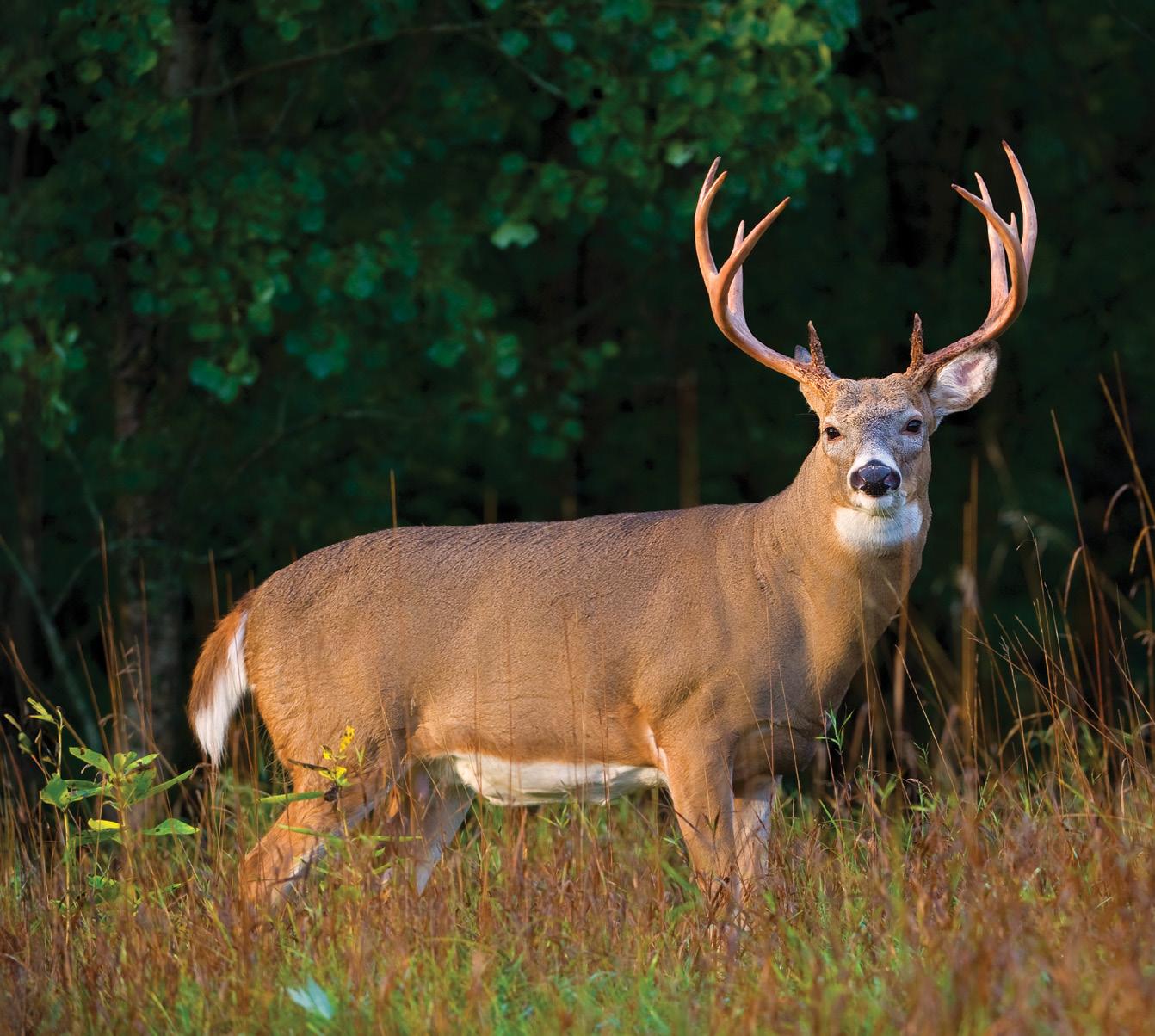
30
BUCKS ON THE BRAIN
HUNTING SPECIAL 2024

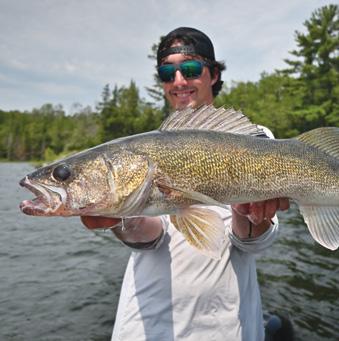

20 22 24 74



Are you wise about whitetails? Take our exclusive quiz and put your deer smarts to the test BY MARK RAYCROFT
38
SPECTACULAR SPECKLEBELLIES

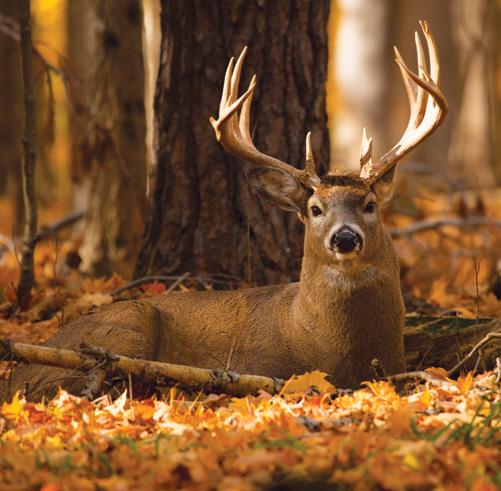
Renowned as excellent table fare, the greater white-fronted goose has expanded its western range, and the hunting opportunities in the process BY KEN BAILEY
46 THE LAST WATCH
For this old hunter, one final foray afield promised to last forever in the great beyond BY L.W. OAKLEY
50 MANIPULATING MOOSE
How to completely outwit a bull into thinking you’re a cow, and lure him into range BY JON R. REMUS
58
ELK ESSENTIALS
From fitness to scouting to calling, everything you need to know to outsmart a wary bugler BY MIKE HUNGLE




66
GO LONG
Big baits catch big fish is an accepted rule of thumb, but for giant pike and muskies, it turns out lanky lures are a better option BY GORD PYZER

www.outdoorcanada.ca

A lot has changed in the world of whitetail hunting over the years, except for one thing: the deer themselves, and the clues they leave behind. Understanding deer sign such as rubs, tracks, droppings and scrapes is key to predicting whitetail movement patterns, which in turn forms the backbone of consistent hunting success. Here’s how to unravel the clues to pattern a big buck this fall, and fill your freezer in the process. outdoorcanada.ca/deersign
RAM QUEST
Earning Whitehorse contributor Vern Peters the prestigious Jack O’Connor Writer’s Award from the Wild Sheep Foundation, this entertaining adventure tale recounts a memorable hunt for Dall’s sheep in the Yukon’s high country. outdoorcanada.ca/ramquest
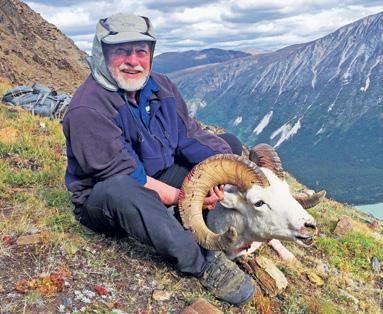
DRAW WEIGHTS
Are heavy draw weights still necessary for bowhunting? Probably not, argues contributor Kevin Wilson. He explains how today’s more efficient bows deliver stored energy better and faster than ever, and what that means for hunters.
outdoorcanada.ca/drawweights
Whether you want a solid workhorse or simply a reliable ride, the proper ATV or side-by-side can be a real game changer. But with such a wide variety of models on offer, how do you choose? Our buyer’s guide helps lead the way. outdoorcanada.ca/theperfectatv
The latest science reveals ciscoes are a hugely important food source for many of Canada’s popular gamefish. Discover how these silvery baitfish can help you catch more and bigger walleye, lake trout, northern pike, bass and muskies. outdoorcanada.ca/ciscosecrets
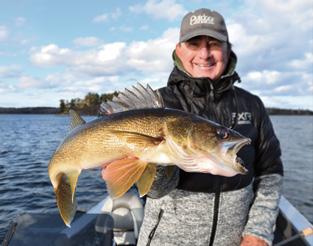





Join us on Facebook Facebook.com/OutdoorCanada
Follow us on X @OutdoorCanada @OutdoorCanadaW
Follow us on Instagram @outdoorcanadamagazine
Follow editor-in-chief Patrick Walsh on X and Instagram @OutdoorWalsh
Follow associate editor Scott Gardner on X @OutdoorGardner
When fall’s angling hordes descend on your favourite river’s most popular steelhead pools, it’s tempting to head home in frustration. Instead, try these expert tips for targeting secret fishing-holding spots others overlook.
outdoorcanada.ca/secretsteelhead
Outdoor Canada fishing editor Gord Pyzer regularly posts expert fishing tips, gear reviews and much more on his blog, “On the water online.” Check in often to stay on top of exciting developments in the world of angling. outdoorcanada.ca/blogs
The all-improved Kubota RTV-XG850 is equipped to increase your efficiency and adrenaline. The already powerful engine is now even faster with 54 horsepower and a smoother ride, making work days shorter to open up more time for play.
Talk to your local Kubota dealer today to find out all the great reasons to get into an RTV-XG850.


BY PATRICK WALSH


THINK OF THEM as the top prizes for the Canadian writers, photographers, broadcasters, editors and more who toil away on outdoor-related books, TV shows, websites and magazines, such as this one in your hands. Every spring, the Professional Outdoor Media Association of Canada (POMAC) reveals the winning entries in its annual National Communication Awards, honouring excellence in content creation. And as always, we here at Outdoor Canada and everyone else in this country’s outdoor media industry awaited the results with bated breath. Once again, it was well worth the wait.
This year, Outdoor Canada staff and contributors picked up six honours in a variety of categories for their work in these pages. Leading the way with second- and third-place wins for his outstanding wildlife photography was veteran contributor Mark Raycroft, whose camerawork you will also see throughout this issue, starting on the front cover. Following up with one win each in the writing categories were contributor Vern Peters (first in hunting features), associate editor Scott Gardner (second in columns) and hunting editor Ken Bailey and fishing editor Gord Pyzer with second and third respectively in fishing features. Well done, gentlemen! Congratulations to you, as well as to all of this year’s other winners.
The accolades didn’t stop there for Ken Bailey, however. He was also named this year’s recipient of POMAC’s prestigious Pete McGillen Award, presented to members who best support the association’s promotion of the outdoors. A member since 1990, Ken has held a wide variety of portfolios with the organization over the years, including president, and most recently played a key role in its rebranding from the former Outdoor Writers of Canada. Currently POMAC’s marketing chair, Ken is not surprisingly only the second member of the association to have twice earned the Pete McGillen Award.
To top it all off, 2024 marks the 30th anniversary of Ken’s first column published in Outdoor Canada, way back in 1994. Cheers, my friend. It’s been an honour and a lot of fun working and hunting with you, and I look forward to even more good times and adventures (and awards!) in the years ahead. OC














ESTABLISHED 1972



EDITOR-IN-CHIEF & BRAND MANAGER Patrick Walsh
ART DIRECTOR Sandra Cheung
ASSOCIATE EDITOR & WEB EDITOR Scott Gardner
FISHING EDITOR Gord Pyzer
HUNTING EDITOR Ken Bailey
EDITOR-AT-LARGE Bob Sexton
PUBLISHER Mark Yelic
NATIONAL ACCOUNT MANAGERS
Rosemary Bubanovich, Jeff Coyle
RETAIL AND CLASSIFIED ACCOUNT MANAGER Chris Holmes
MARKETING MANAGER Desiree Miller
DIRECTOR OF RETAIL MARKETING Craig Sweetman
AD TRAFFIC COORDINATOR Michaela Ludwig
DIGITAL COORDINATOR Lauren Novak
CIRCULATION & CUSTOMER SERVICE
Marissa Miller, Lauren Novak
CONTROLLER Anthea Williams
OUTDOOR CANADA IS PUBLISHED BY OUTDOOR GROUP MEDIA LTD.
Outdoor Canada magazine (ISSN 0315-0542) is published six times a year by Outdoor Group Media Ltd.: Fishing Special; May/June; July/August; Hunting Special; November/December; and January/February. Printed in Canada by TC Transcontinental.
SUBSCRIPTION RATES: Canada, one year (six issues), $24.95 plus tax. U.S., one year, $39.95. Foreign, one year, $69.95. Send name, address and cheque or money order to: Outdoor Canada, 802-1166 Alberni St., Vancouver, B.C. V6E 3Z3
MAIL PREFERENCE: Occasionally, we make our subscriber list available to carefully screened companies whose products and services may be of interest to our readers. If you want your name removed, contact us via the subscripton contact below.
Publication Mail Agreement No. 42925023. Send address corrections and return undeliverable Canadian addresses to: Outdoor Canada, 802-1166 Alberni St., Vancouver, B.C. V6E 3Z3
USPS #014-581. U.S. Office of publication, 4600 Witmer Industrial Estates, Unit #4, Niagara Falls, N.Y .14305. U.S. Periodicals Postage paid at Niagara Falls, N.Y. Postmaster: Send address changes to Outdoor Canada, P.O. Box 1054, Niagara Falls, N.Y. 14304-5709. Indexed in Canadian Magazine by Micromedia Ltd.
EDITORIAL SUBMISSIONS: We welcome query letters and e-mails, but assume no responsibility for unsolicited material.
Distributed by Comag Marketing Group. ©2024 Outdoor Canada. All rights reserved. Reproduction of any article, photo or artwork without written permission of the publisher is strictly forbidden. The publisher assumes no responsibility for unsolicited material.
Subscriptions and customer service: 1-800-898-8811
Subscriptions e-mail: service@outdoorcanada.ca
Customer service website: www.outdoorcanada.ca/subscribe
MAILING ADDRESS: Outdoor Canada, 802-1166 Alberni St., Vancouver, B.C. V6E 3Z3
General inquiries: (604) 428-0259
Editorial e-mail: editorial@outdoorcanada.ca
Members of the Manitoba Wildlife Federation, Saskatchewan Wildlife Federation and Alberta Fish & Game Association must contact their respective organizations regarding subscription questions or changes.




BY MARK RAYCROFT
Invasive wild pigs killed under two recently concluded eradication programs in Alberta. Both a twoyear trapping program that ended in late March, and a oneyear bounty initiative that ended a year earlier, failed to remove any of the destructive, diseasespreading animals.
75%
Years the moratorium on Newfoundland and Labrador’s commercial fishery for northern cod was in place until it was lifted in June. However, the move represents only a small increase in fishing above the exceptions already allowed in recent years. This year, the catch will be capped at 18,000 tonnes, well below the 250,000 tonnes hauled in during the late 1980s. 0 32
Drop in moose draw licences issued this year in four of Manitoba’s 62 game hunting areas. The province says the reduction is designed to sustain moose populations and meet the needs of First Nations harvesters, yet still offer opportunities for nonIndigenous hunters.

1 million
Acres of land conserved across North America by Ducks Unlimited during its fiscal 2024 year. The milestone marks the first time in its 87-year history DU has rallied landowners, hunters, corporations, donors and government agencies to set aside 1 million acres in one year, now bringing its total to more than 18 million.
Conservation groups from 15 countries demanding Ottawa keep its promise to remove open-net fish farms along B.C.’s coast, where they threaten wild salmon stocks. Spearheaded by the Watershed Watch Salmon Society and Global Salmon Farming Resistance, the June call to action included the B.C. Wildlife Federation as a signatory. 46
Silly boys. A trio of young woodland caribou tussle in the Newfoundland wilds last October, oblivious to a large herd bull passing by to tend to his harem.
PHOTO BY MARK RAYCROFT


“We need justice, not more poisoning.”

Chief Rudy Turtle of Grassy Narrows First Nation calls for immediate action after a new study revealed the fish his northern Ontario community rely on continue to be contaminated with mercury. Western University researchers found that sulphate dumped into the Wabigoon River from a paper mill upstream in Dryden is reacting with bacteria and existing mercury contamination to form even more toxic methylmercury. Says Turtle: “This has made our suffering worse and it has to stop.”

CANADA’S NATIONAL BASS-FISHING TEAM AIMS TO TAKE ON THE WORLD
BY BOB SEXTON
FOR WHAT SEEMS like the 1,500th time, Norm Hayman casts a white-skirted buzzbait with impressive accuracy towards a patch of weeds along the shoreline of Ontario’s Lower Buckhorn Lake. As he quickly retrieves the gurgling topwater, the water suddenly explodes behind it. “Damn! He just missed it,” Hayman says, pointing to where the bass appeared. “Quick! Throw your worm out right there and see if you can get him.” With considerably less accuracy, I cast my unweighted wacky rig and wait 10 tense seconds for a hit, but nothing happens. Thankfully, our boat’s livewell is already full with a limit of respectable largemouth and smallmouth bass.
As co-anglers in the 2nd Annual Canada Bass Pro/Am out of the Kawartha region’s Beachwood Resort, Hayman and I are fishing alongside our host, bass pro and fishing guide Joe Ford. The vice-president of the Canadian International Sportfishing Association (CISA), Ford is also one of the event’s key organizers. To be honest, he and Hayman have contributed most of the fish in the boat, so it’s painfully clear—to me, at least—who’s representing the “amateur” in this lateJune pro/am. Granted, I’ve caught my fair share of bass over the years, but these guys are in a different league altogether.
“Okay, Buzz King,” Ford says to Hayman, who’s fishing in the back of the boat. “It’s time to catch us a five-pounder.” Hayman is the founder of Bass Freaks Canada, a series of regional social media sites for bass-fishing enthusiasts across the country. So far, his relentless casting has been paying off, resulting in three decent fish in the last hour alone. “You have to put a lot of miles on a lure to get bit,” he says. “I love buzzbaits because you can cover so much water with them.”
Meanwhile, I’ve only caught one keeper with my wacky rig, but I’m not too stressed about it. The point of this friendly tournament isn’t to take home a cheque, after all, but to raise funds for CISA’s national bass-fishing team—Team Canada—as it prepares for upcoming international competitions. Those include late-September’s 5th Annual Pan American Black Bass Championship in Nacka-
wic, New Brunswick, and the Black Bass World Championship on Italy’s Bolsena Lake in October.
While Hayman and I are attending as media guests, each of the 19 other teams in today’s tournament paid $1,000 for the chance to fish with one member of Team Canada in the morning, and another in the afternoon. Prior to Ford in the afternoon, Hayman and I also fished with veteran bass pro and Team Canada member Dave Chong during the morning session.
The September 25 to 29 Pan American in Nackawic, New Brunswick, will see two-person teams from several countries fish for medals and national pride on the Saint John River, which is also known by its indigenous name, Wolastoq. At press time, participants from the U.S., Mexico, Puerto Rico, Colombia, Costa Rica and the Dominican Republic had been confirmed. Along with Team Canada, there will also be teams from Ontario’s Curve Lake First Nation and New Brunswick’s Wolastoqiyik Nation.
As well, teams from southern Africa will be competing against Team Canada and the USA Bass Team in the concurrent Challenge Cup, a sort of “tournament within a
tournament,” Ford says. “This Pan Am is going to be pretty special. It’s going to be one for the ages.”
Most of Team Canada’s eight pairs of pro anglers made the squad by placing highly at one of two events: last September’s Canada Bass/CISA Pan Am Qualifier on the St. Lawrence River in Ontario, and last May’s Destination Nackawic Smallmouth Open in New Brunswick. The successful members include Dave Chong, Steve Neveu, Adam Howell, Corey Gaffney, Jason Hare, Graeme Mace, Rick Kewell, Jason Hynes, Phil Curtis, Brent Valere, Bob MacMillan, Adam Foster, Jim Tzogus, and Ben and Jon Stokdijk. Also included are three special members, Bassmaster Elite Series anglers Cooper Gallant and Jeff Gustafson, who won the 2023 Bassmaster Classic, and fishing TV icon Bob Izumi as captain.
In case one of the pairs has to drop out, there is also one alternate duo, of which Ford himself is a member. No stranger to international competition, he’s earned three gold medals with Team Canada since it was first established in 2018 prior to the Pan America event on Florida’s Lake Okeechobee.
Unlike the last time the Pan American was held in Canada—in Cornwall, Ontario, in 2019—the organizers have had plenty of time to prepare for September’s event out of the newly built Big Axe Marina on the Saint John River. “The 2019 Pan Am was a good event, but this one is going to blow the doors off any predecessors,” Ford says. “It has an unprecedented amount of provincial and municipal support.”
Team Canada member and CISA media director Adam Foster agrees. “There’s direct involvement between the municipalities, including Destination Nackawic and Capital Tourism Fredericton, where they’re facilitating the logistics of putting on such a big show,” he says.
Originally from Nova Scotia, Foster now lives in Nasonworth, New Brunswick, and has been fishing the Saint John for close to a decade. He knows the fishery well, and is confident in the event’s success, noting that 50- to 100-fish days are common. And while he concedes Great Lakes bass might be bigger, Foster maintains their finned cousins down East are “a little more hearty.”
According to Ford, the tournament will also give CISA a valuable opportunity to showcase its mission. “CISA’s values are to support the competitive sportfishing community and build strong partnerships with host communities,” he says, while also noting the economic benefits the tournament will bring to the region. “We’re going to show the province of New Brunswick a $2 million economic impact for a five-day event.”
Ultimately, Ford says, CISA aims to build on the Pan American tournament and eventually host the Black Bass World Championship. Another goal of putting on an international fishing tournament of this type, Bob Izumi points out, is to strengthen the global campaign to get fishing recognized as an Olympic sport. He acknowledges it’s a complicated process (see “Olympic Games goal”), but says the more countries that get involved, the better the chances of success.
Back at Lower Buckhorn’s Beachwood Resort, the time has come for the organizers of the Pro/Am tournament to hand out trophies, hold an auction and thank the participants. “We’re a not-for-profit corporation, so we don’t make money,” CISA president Brent Valere tells the assembled anglers. “We have to fund ourselves and you guys are helping in a very large way.”
When he finally announces the winners, I’m surprised and a bit sheepish, as Norm Hayman and I have placed third, with a total weight of 17.15 pounds for six fish. I know it’s all due to Hayman’s buzzbait and the multiple fish Joe Ford and Dave Chong contributed, but I can’t lie: it feels good to be part of a winning team. Team Canada star member Jeff Gustafson certainly knows what winning feels like, and he’s excited about Canada’s chances at September’s Pan American. “We want to continue to show the rest of the world that Canada has some great bass anglers,” he says. “And when they come to our country, we want to show them who’s the boss!” OC
How far along is the bid to get fishing into the Summer Olympics? Despite ongoing efforts, it has yet to be recognized as an official Olympic sport, which is the mission of the International Sport Fishing Confederation (known by its French acronym, CIPS). Founded in 1952, Rome-based CIPS comprises 152 fishing federations from 79 countries and represents several fishing disciplines, including fresh- and saltwater angling, fly fishing, ice fishing, kayak fishing and casting. The Canadian International Sportfishing Association is a member of the International Fresh Water Sport Fishing Federation, which is the freshwater angling arm of CIPS.

CIPS has been handling the proposal to get fishing back into the Olympics—it appeared as an unofficial sport in the 1900 Paris games—but doing so has been a long and arduous process. The International Olympic Committee (IOC) denied an application for recognition in 2016, for example, but efforts continue.
“Progress is moving at an exasperatingly slow pace,” says CIPS vice-president and USA Bass Team manager John Knight. The latest obstacle, he says, is that the IOC is reluctant to consider fishing because it involves an animal. He says that argument doesn’t hold much water, however, considering equestrian sports are part of the Olympics.
Overall, Knight says he remains optimistic, pointing to some recent streamlining of the byzantine recognition process. In 2022, all the international federations that were part of the Global Association of International Sports Federations merged into a new organization called SportAccord. Now representing both Olympic and non-Olympic international federations, including CIPS, it is establishing a new procedure for the official recognition of new Olympic sports.
Adding to Knight’s optimism is the fact CIPS president Claudio Matteoli is a close friend of Ivo Ferriani, the president of SportAccord. “He has discussed our efforts to be recognized several times with the president of SportAccord,” Knight says. “We hope that the time is not very far from having recognition.” Meanwhile, CIPS membership continues to grow, with the organization recently welcoming Iran, India, Bulgaria, Lebanon, Philippines and Jordan to its ranks.
TROPHY WALL
WE ENJOY SEEING pictures of your fishing and hunting accomplishments—and learning the stories behind them. Please e-mail us your images, along with any relevant details (who, what, where and when), and we’ll post them on Instagram and publish our favourites here.

With just minutes of legal light remaining one evening last September, then 18-year-old Kayden Brunner dropped this impressive 7x8 elk in its tracks while hunting with his father, Travis, in their home province of Saskatchewan. “He made an amazing shot,” says Travis, noting it was the pair’s first-ever elk hunt.

Hunting with RockRidge Outfitters in Battersea, Ontario, early last October, Mary-Kate O’Hara-Skubel took this chunky young whitetail, her first-ever buck, with her crossbow. It was a great follow-up to the day before, when the avid hunter shot her first-ever wood duck.

Working hard to develop her archery and tracking skills paid off for 13-year-old Nemiah Curliss last September when she harvested her first-ever elk while hunting with her dad, Rob, on Vancouver Island. Says proud mom Siri: “I think it’s safe to say that she’s now hooked on hunting for life!”
Start ’em young!
Three-year-old Rylin
Clipping happily holds up two spruce grouse his father, Sandy, knocked down late last September while the pair were hunting north of their home in Thompson, Manitoba. Says Sandy: “He’s going to be a great hunter and fisherman with my guidance.”

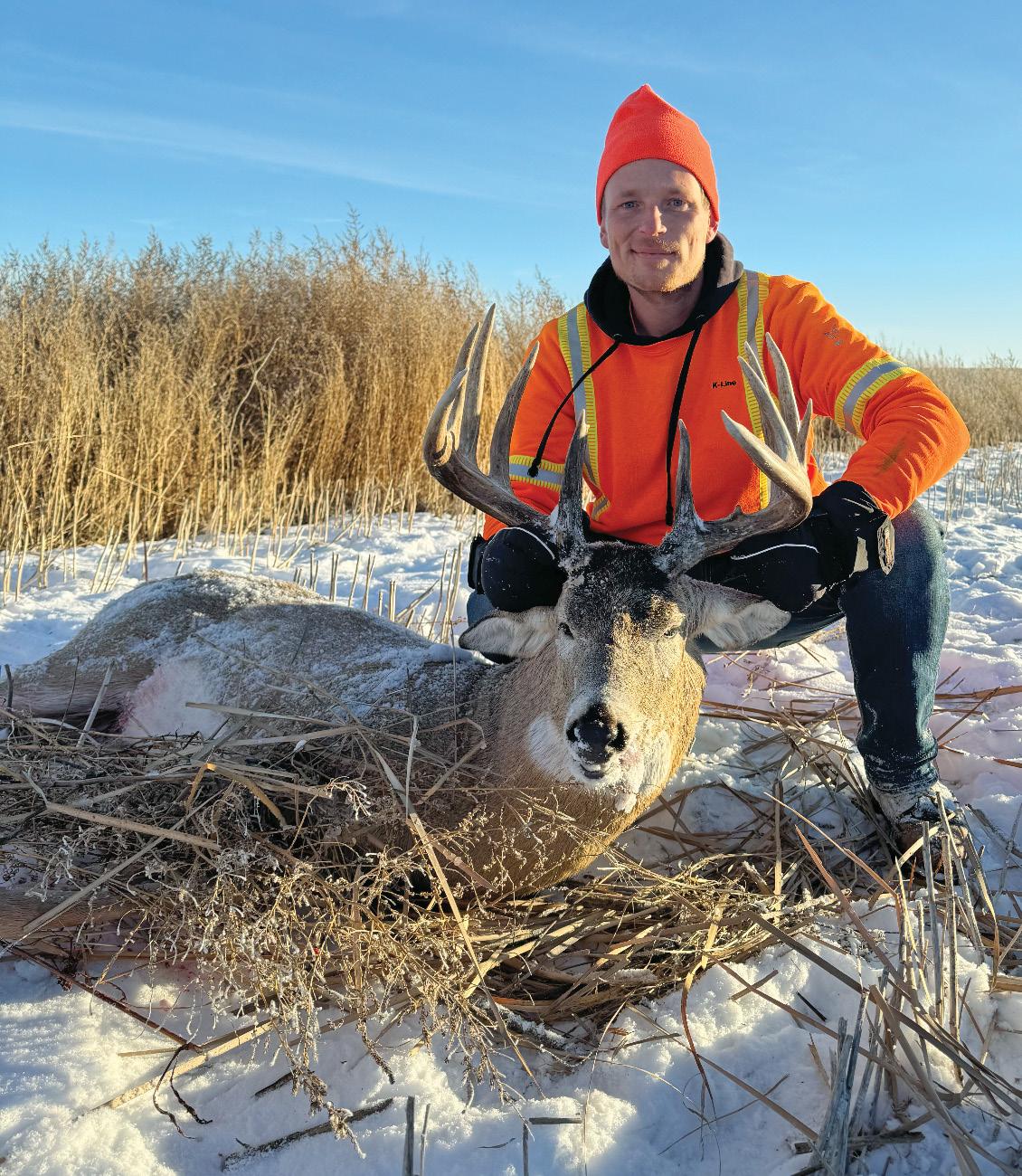
White City, Saskatchewan’s Dylan Sydorko was rifle hunting in the southeast of his province when he took this dandy whitetail last November. “It was a once in a lifetime shot at this great Saskatchewan buck,” says Dylan noting the deer ended up scoring more than 160.
Since he was just five, Alexander Wood has been joining his dad, Nathan, on deer hunts. Then last October, at age 12, he finally carried a tag of his own and arrowed this fine buck, with his great pal Rylan Bodnarchuk (right) looking on. As his mother, Candace, observes, “Alex will never forget this first hunt.”
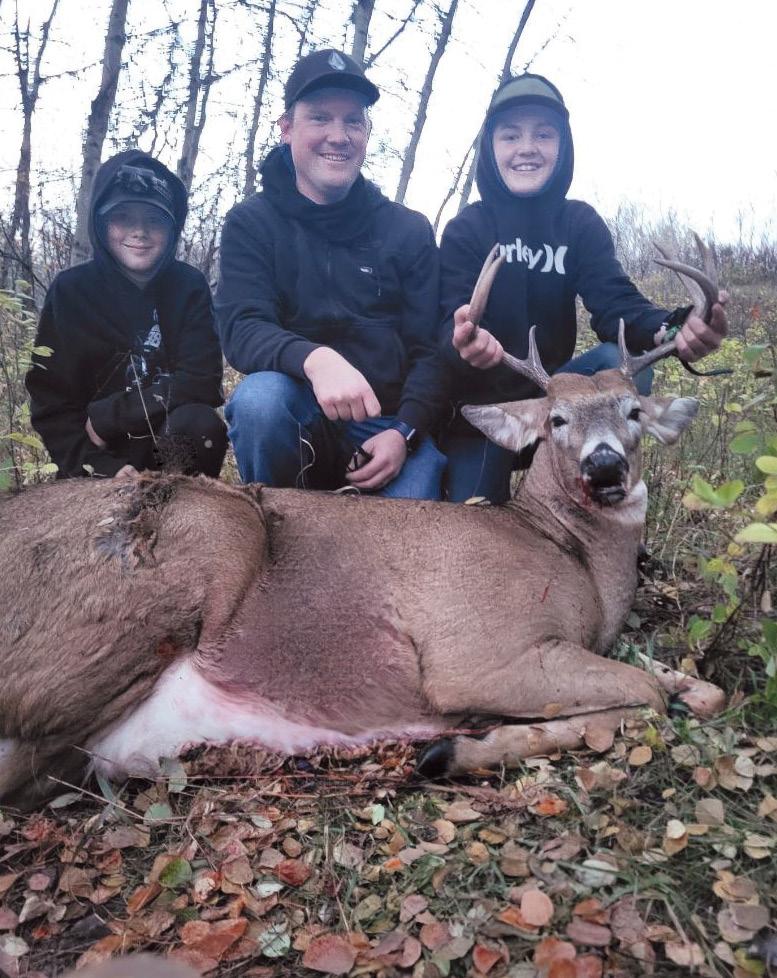
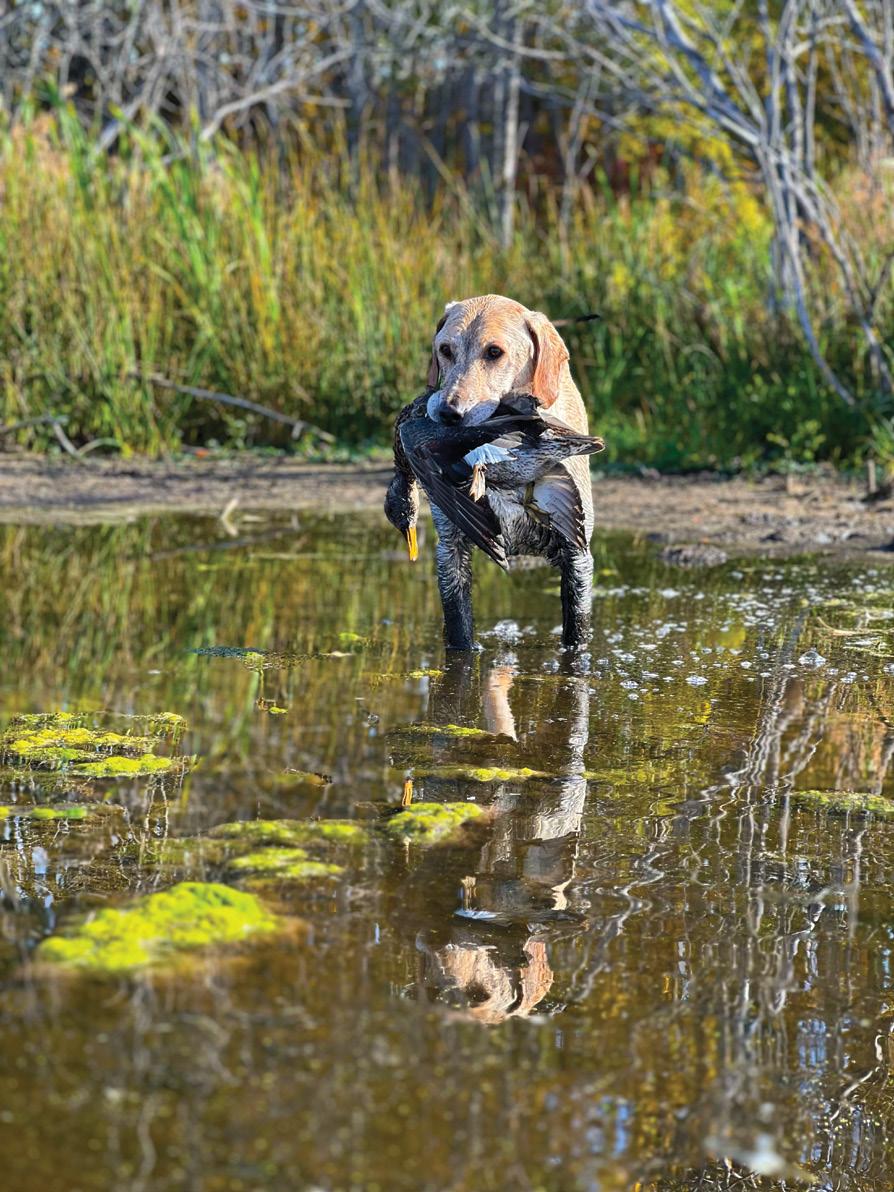
Seven-year-old Benny happily retrieves a downed gadwall hen for his hunting buddy, Brent MacDonald, from a slough near St. Paul, Alberta, last September. Also known as Benelli SuperNova, the yellow Lab has been an active bird dog his entire life.

King City, Ontario’s Paolo Marcelli and his father, Giovanni, were hunting with Leslie Lake Outfitters in a remote area of Newfoundland’s Moose Management Area 2 when he took this massive bull. It ended up scoring 1803⁄8, pipping the big bull his father shot earlier in their September adventure. OC

ENJOY THE FLAVOURS OF GREECE WITH TZATZIKI-DIPPED SKEWERS
RECIPE & PHOTO BY CAMERON
TAIT
BARBECUED VENISON STEAKS are great, but why not try something completely different with this Greek-inspired fare?
Skewers of tender grilled venison served with warm pita bread and sharp tzatziki sauce make for a fresh and delicious change-up. For the best results, I recommend using your coveted backstrap, tenderloin or sirloin cuts. Serves 4
1] Combine marinade ingredients in a sealable container, then add venison and mix well. Place in fridge for 24 to 36 hours to marinate.
2] Combine tzatziki sauce ingredients in a bowl, mix thoroughly and set aside in fridge.
3] Once venison has marinated, build the skewers by alternating pieces of venison, peppers and peach.
4] Set barbecue on hottest setting and grill skewers for approximately five minutes on each side, basting occasionally with remaining marinade.
5] Serve with grilled pita bread, small potatoes and tzatziki sauce, and garnish with sliced red onion.

MARINADE
• ¼ cup olive oil
• 2 cloves garlic, chopped
• 1 tsp dried oregano
• 2 tbsp balsamic vinegar
• 1.5 lb venison, well-trimmed, one-inch dice
TZATZIKI SAUCE
• 500 ml plain Greek yogurt
• ½ English cucumber, grated, excess water squeezed out
• 1 tbsp lemon juice
• 1 clove garlic, chopped
• ½ tsp paprika
• 1 tsp dried dill
• Kosher salt and black pepper, to taste
SKEWERS
• 4 metal or soaked wooden skewers
• 1 each red and yellow peppers, diced one inch
• 2 peaches, cut in wedges
What’s a BBQ without beer?
For this dish, you can’t beat a glass of well-chilled Witbier from the Ontario brewer Creemore Springs. Featuring a touch of clove, banana and citrus, this cloudy, Belgian-style wheat beer pairs well with grilled vegetables and venison.

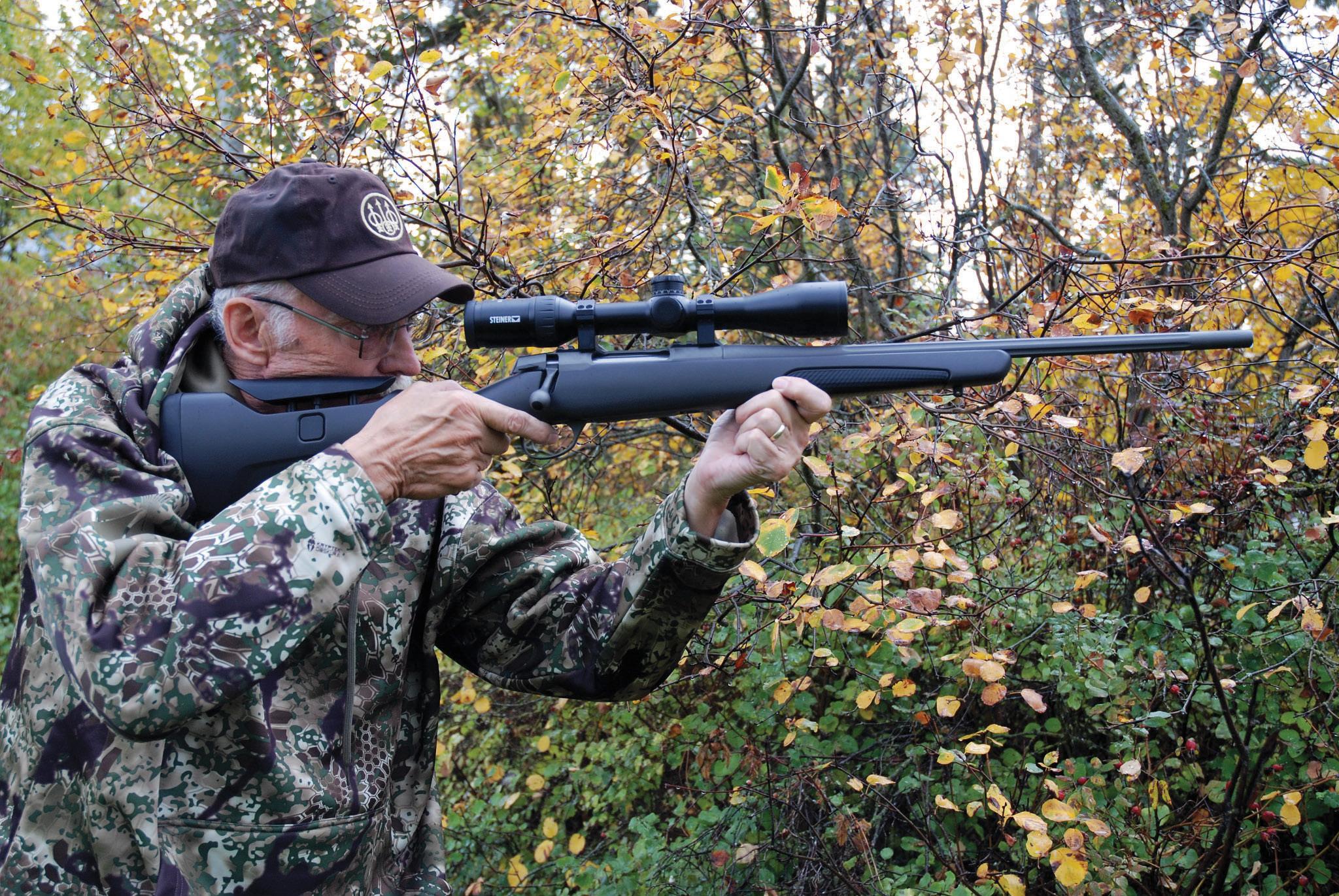
BY MARK HOFFMAN
I’VE NEVER OWNED or tested a Sako rifle that I could not get to shoot well, some having such surgical precision they left me in awe. That includes my earliest Sako rifles, which predated the era of synthetic stocks and the popularization of MOA accuracy as the standard for centrefire hunting rifles. But accuracy is just part of the Sako legend. The ultra-smooth actions are renowned for cycling as if on ball bearings, while the company’s dedication to quality, finish and detail are second to none. Throughout the years, Sako has not only maintained that high level of quality, it has also added improvements to each model as it comes on stream. And its latest offering, the Model 90, carries on the tradition.
The Model 90 is offered in seven versions, three dedicated to mountain and backcountry hunting, and four designed for more traditional small- and biggame adventures. The Adventure, which I tested, falls into the latter grouping. It is offered in 14 calibres, from .22-250 Rem. to .300 Win. Mag. (I opted for .308 Win. for my test model). Along with the various chamberings, the entire design and function of the Adventure is aimed at providing an all-purpose, take anywhere rifle.
It features an adjustable, low-noise fibreglass stock, which is reinforced with carbon fibre. Also notable are the Sako match-grade, cold-hammer forged barrel, multi-adjustable Sako trigger, and carbon-fibre reinforcements around the receiver and recoil lug. It also has a tungsten Cerakote-coated stainless steel action that features a machined-in Picatinny interface.
Sako claims its bolt “is the most reliable, field-tested and proven bolt on the market.” As verification, it has been cycled more than five million times without a failure. Considering the three-locking lug design, it would be difficult to argue with that assessment. And when combined with the Model 90’s reinforced and improved receiver, the action is smoother, faster and more reliable than ever.
As for the trigger, it offers a world-leading lock time of under 1.3 milliseconds. It also has five clearly marked pull-weight adjustability settings (without disassembly) that collectively make for an outstanding, user-friendly and accuracy-
generating trigger. The trigger blade position is also adjustable for optimum ergonomics and hand sizes.
Adding to its performance, the Model 90 utilizes a flat receiver bedding that generates improved repeatable accuracy over traditional, more common round receivers. By allowing gases to escape evenly, the precisely crowned barrel muzzle also contributes to the rifle’s accuracy.
I was immediately impressed with the Adventure’s compactness, manoeuvrability in tight spaces and light weight. Even after adding a Steiner Predator scope with its 2.6-ounce sleek and rugged H-series rings, the rifle weighed in at just eight pounds even.
Also impressive was the trigger, and the user-friendly access to the trigger-pull weight adjustment. The trigger itself was perfection. It broke consistently with no creep or overtravel between three pounds and three pounds one ounce. Notable as well were the ultra-smooth cycling of the bolt, and the perfect eye-to-scope sight alignment provided by the adjustable comb.
As for the scope, it certainly provided a multi-purpose match for the Adventure. While the lower magnifications are ideal for the woods, the ballistic turret and 16x magnification unquestionably extends the potential beyond that of a short-range woods rifle. (Also see “Steiner Predator,” next page.)
On the range, the rifle did not disappoint. Nor did it alter my claim that I’ve yet to find a Sako rifle I could not get to shoot well. It did have some likes and dislikes in terms of ammo, however. Every one of my five handloads bettered MOA accuracy, which collectively averaged 0.737 inches. The best of the lot was Hornady’s 165-grain CX bullet, which delivered a 0.570-inch group with BL-C 2 powder. As a whole, the 11 factory loads did not fare as well, offering a 1.108-inch average.
The star of the show, however, was Sako Super Hammerhead’s 180-grain Bonded Soft Point ammo, with an outstanding 0.280-inch group. Actually, all three Sako loads shot well, with an average of 0.579 inches. I did
note, though, that the Super Hammerhead 150s showed incipient pressure signs, with a sticky bolt lift. This may have been rifle-specific, but I suggest caution is warranted in very hot weather.
For deer- and black bear-sized game, I would not look beyond either a Hornady 165-grain CX handload or any of the Sako offerings I tested. For moose and elk at reasonable ranges, I would even include Sako’s Super Hammerhead 180-grain Bonded Soft Point ammo.


• Calibre: .308 Winchester
• Weight: 6.4 lb
• Total length: 40.1"
• Barrel length: 20.1"
• Rate of twist: 1:11"
• Magazine capacity: 5 rounds
• Drop at comb: Adjustable
• Length of pull: Adjustable

My test rifle arrived with a Predator 8 scope from Steiner’s new series comprising 2-16x42, 3-24x50 and 4-32x56 models. The company says it’s the “most versatile and precise line of hunting optics ever made by Steiner featuring the powerful 8x system.” With its broad application magnification range and objective lens size, my 2-16x42 test scope was as an ideal match for the Adventure.
The lightest and most compact scope in the line-up, it features an integrated, customizable ballistic turret giving hunters the ability to accurately compensate for bullet drop. And when the need for speeddialing arises, there are three numbered movable rings that can be set to preferred distances. The turret’s audible and tactile mechanics provide sure and intuitive operation, while the Zero Mode lets you quickly return to zero without losing the sight picture.
Additional features include highcontrast glass, best-in-class clarity, an extra-wide field of view and industry-leading light transmission. Plus, the high-contrast lens coatings
ensure brilliant, crisp images with edge-to-edge sharpness and optimum detail recognition.
If you’re hunting at twilight or extended ranges, or in the wind, the Predator offers an illuminated reticle with 11 brightness settings, a rear focal plane E3 Ballistic reticle with cascading subtensions, and windage dots for blustery days.
As well, the scope is nitrogen-filled for fog-proofing and waterproofing to three feet. It comes with the transferable Steiner Heritage Warranty, which includes full replacement at no cost for the life of the product (the electronic components are covered for three years). OC
• Magnification: 2-16x
• Objective lens diameter: 42mm
• Tube size: 30mm
• Length: 13.5"
• Weight: 23.4 oz
• Field of view at 100 metres: 7.7' to 62.07'
• Eye Relief: 3.7"
• Parallax: 20 yards to infinity
When it comes to hunting, gun dog injuries are sometimes an unfortunate reality. Mishaps can range from minor scrapes to life-threatening trauma. After an accident, the value of a dedicated canine first-aid kit—and knowing how to use it—is vital to proper care.

THE KIT A comprehensive kit should be able to treat a variety of injuries. For cuts and scrapes, include a syringe or sealable plastic bag with a cut corner to irrigate the wound, and cotton swabs to remove foreign material. You’ll also need chlorhexidine (an antiseptic), nonadherent gauze pads, medical tape and bandage scissors. As well, EMT Gel for dogs is perfect for sealing and protecting minor cuts. To hold bandages in place, include gauze or vet wrap, which sticks to itself, not the dog’s fur. Removing embedded thorns and porcupine quills, meanwhile, requires good-quality tweezers and needle-nose pliers. Torn toenails are excruciatingly painful for dogs and must be trimmed, so also include a small pair of side cutters (which also come in handy if your dog gets caught in a snare or wire fence). Finally, don’t forget a dog-safe antihistamine such as Benadryl for insect stings and allergic reactions.
EXTRAS To further ensure the proper care and comfort of your injured dog, also consider including these items. For freeing up your hands to treat injuries in the dark, a headlamp is invaluable. A skin stapler, meanwhile, is a practical tool for tacking skin edges over a wound until you get to a vet. And to prevent your upset dog from possibly biting you during treatment, include a muzzle. Finally, when you’re away from home, bring along the phone numbers and addresses of the local veterinarians. Should an emergency arise, you’ll be glad you did.
—LOWELL STRAUSS
WHEN COMES TO REMAINING CONCEALED, THESE LATEST BLINDS HAVE YOU COVERED BY THE EDITORS
WHETHER YOU HUNT with a rifle, shotgun or bow, ground blinds offer concealment from game, shelter from the elements and even some scent control. These days, models range from semi-permanent structures to simple, easy-to-move pop-ups, all available in a wide variety of sizes, shapes and camo pat

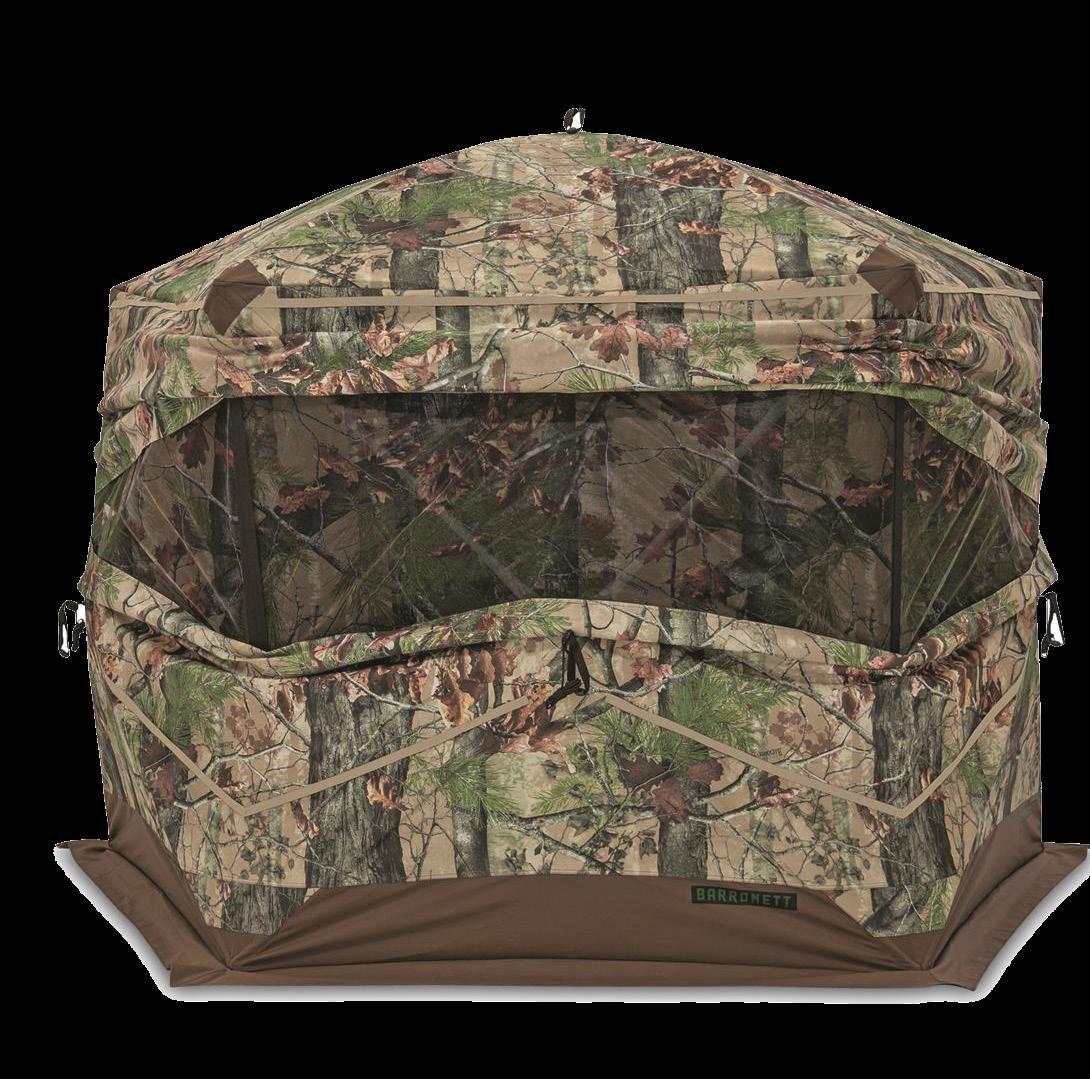
OX 5 (US$399.99)
Barronett Blinds, www.barronett blinds.com
Key features: Fivesided design; 70 per cent more room than traditional hub blinds; made of Barronett’s OxHide fabric; fibreglass poles; adjustable panoramic shooting windows. The prom ise: “Built to withstand repeated use.”
THE STUMP SEQUOIA SCOUT (US$4,799)
Banks Outdoors, www.banksoutdoors.com
Key features: Made of UV-stabilized polyethylene, with a paintable, bark-like texture; interior is 90 inches wide and 80 inches tall; includes skis, tow hitch and gun shelf. The promise: “A 360-degree view for excellent visibility.”

DELUXE TENT CHAIR BLIND (US$209.99)
Ameristep, www.ameristep.com

Key features: Durable flip-over polyester shell in Mossy Oak Break-Up Country; one twoseated chair; sets up in 30 seconds; includes carrying case with shoulder strap. The promise: “Ideal for firearm and crossbow hunting.”
HYDEOUT (US$399.99)
Rig ’Em Right Outdoors, www.rigemright.com
Key features: One-person hub-style; double-layer polyester; 360-degree view; large windows for multiple shot and archery angles; removable reflectors to locate blind in the dark. The promise: “Stay warm, dry and invisible.”

WARRIOR BLIND-CHAOS (US$599.99)
Hawk Treestands, shop.hawkhunting.com
Key features: Accordion-style design with aluminum frame; 360-degree view with six archery and six gun windows; silent magnetic doors and curtains. The promise: “Sets up/tears down in less than five minutes.”


HUNTING BLIND ($499.99)
Cabela’s/Bass Pro, www.cabelas.ca
Key features: Steel frame with rugged polyester shell and ground skirt; brush straps to add foliage; four small and four large windows; large zippered door. The promise: “Ideal for hunting on farmland.”
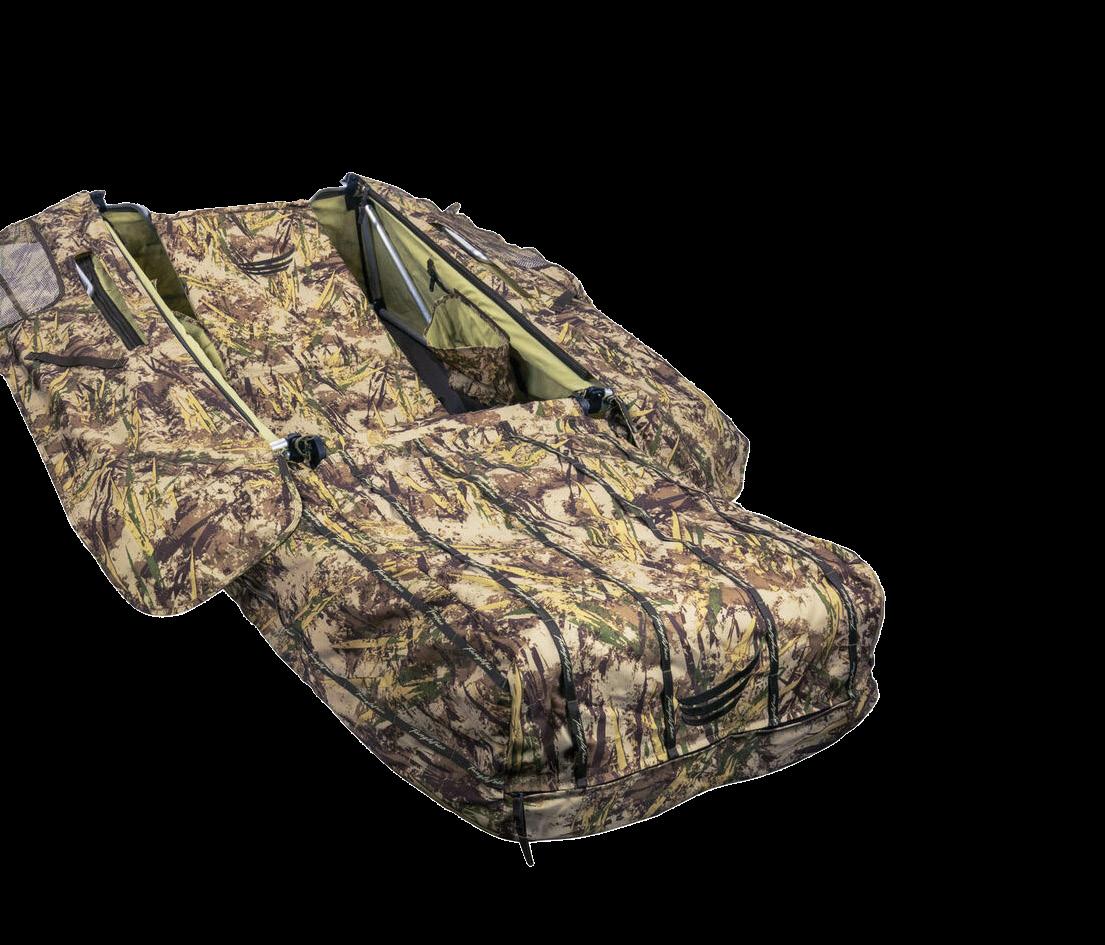
ZONE BLIND ($489.60)
First Lite, www.firstlite.com
Key features: Oversized footprint measuring 84 by 37 inches; aluminum frame; insulated flooring; large mesh viewing area. The promise: “A layout blind big guys will be comfortable and successful in.”
DOUBLE BULL ROUGHNECK GROUND BLIND COMBO (US$299.99)
Primos Hunting, www.primos.com
Key features: Aluminum hub system; Primos’ Double Bull fabric; silent triangle door; shoot-through window mesh; brush straps on roofline; includes two tristools. The promise: “Unmatched sturdiness and durability.”


PANEL BLIND (US$259.99)
TideWe, www.tidewe.com
Key features: Pop-up hub design, with two front and two side panels; brush loops; dog door; multiple pockets and pouches; attachments to connect other blinds. The promise: “Can withstand strong winds and adverse weather.” OC
Building on its Reveal X 2.0 and X-Pro trailcams, Tactacam has ramped things up with the Reveal X 3.0 and Reveal Pro 3.0 (US$119.99/ US$149.99). Capturing 4K quality images and HD video sent straight to a smartphone or computer, the new models also feature a builtin GPS, pre-installed antenna, integrated SIM card, No-Glow IR flash and much more. cam, www.tactacam.com

To mark its 30th anniver sary, Columbia River Knife & Tool has introduced a new all-purpose fixed-blade hunt ing knife, the Soldotna (US$200). It features a 1095 carbon steel drop-point blade with a Cerakote finish, and a tan canvas micarta handle. Designed by professional guide Rod Bremer, the knife comes complete with a black leather sheath.

Made for hungry outdoor adventurers on the go, Weber’s Traveler Portable Griddle ($319/$399) comes in 17- and 22-inch versions. With its four adjustable feet for use on uneven surfaces, the Griddle is designed to provide even, edge-to-edge heat for consistently cooked fresh fish and more, anywhere in the outdoors. Weber, www.weber.com


Promising to dispel myths and reveal secrets about black bears, The Ultimate Authority on Hunting Trophy Black Bear ($59.95) offers 550plus hunting tips and photos garnered over decades of field research. Touted as “Canada’s most versatile guide,” author Jon R. Remus says even seasoned hunters will learn some new tricks for fooling old boars. Venture North Outdoors, www.venturenorthoutdoors.com

BY T.J. SCHWANKY
BY GEORGE GRUENEFELD
BY GEORGE GRUENEFELD
THANKS TO A successful smear campaign, the term “trophy hunting” has been appropriated by anti-hunters to conjure up negative connotations. They want non-hunters to believe trophy hunters are rich slobs who travel the world murdering endangered species and leaving the meat to rot. The Society for the Prevention of Cruelty to Animals, for example, states bluntly that “trophy hunting is the hunting of wild animals for sport, not for food.” As a result of such misinformation, some hunters are understandably shying away from the term, but isn’t it time we took it back instead?
Trophy hunting has slightly different definitions in various parts of the world, but to most hunters, it simply means hunting a mature male animal. The notion that meat is wasted is ridiculous. In most of North America, the flesh from hunted animals must be consumed by law, and in Africa, where the antis are focusing much of their effort, such meat is a precious commodity. Not only is it all consumed, but so too are the organs and bone marrow. In many parts of Africa, in fact, hunter-supplied meat is the only source of protein.
The anti-hunting movement has become so convincing that many countries are banning the import of animals taken in Africa. Canada recently stopped the import of rhino and elephant trophies, for example, despite there being a surplus of those animals in some parts of the continent, where hunting is an important part of their conservation. The ban is strictly for social reasons, with no science to support it. In most cases, the science actually supports hunting.
The antis are well-funded and masters at playing on emotion. They start with high-profile, iconic animals that most people have never seen outside of a zoo. It’s easy to convince the average non-hunter—and even some hunters—that elephants are near extinction and there’s no reason to hunt them. The same ploy was used to end B.C.’s grizzly bear hunt in 2017. Make no mistake, the antis are selecting these animals not because they are in danger from hunters, but because they are easily used to garner public sympathy. The antis’ ultimate goal is the abolition of all hunting, but it’s a long game of patience and they are starting with the low-hanging fruit.
So, should hunters shy away from the term trophy hunting? And do we need to stop hunting some of these iconic species with the hopes the antis will leave
us alone? It would be nice to think that would make a difference, but it would only embolden the foes of hunting. Rather than continue to lose ground to them, we need to start taking some back instead, and the term trophy hunting is a good place to start.
In several recent polls conducted in Canada, approximately 70 per cent of respondents said they supported hunting for meat, but only 10 to 15 per cent supported trophy hunting. The two are essentially the same thing, but it shows how effective the antis have been. We need the public to stop believing the anti-hunting rhetoric, and to understand trophy hunting is meat hunting, too. It’s just a more selective harvest of mature male animals.
As hunters, we also need to hold ourselves to the highest standards and distance ourselves from those who willingly break the law to secure a trophy animal. The media often uses the terms “poacher” and “hunter” interchangeably. They aren’t.
We also need to educate those around us about the realities of trophy hunting, that it’s an important part of science-based wildlife management. We must show trophy hunters are no different than more socially acceptable meat hunters, other than being more selective about what they harvest.
As for trophy hunters who travel abroad, they also play an important role in science-based wildlife management, with the added benefit of providing much needed income to often impoverished parts of the world. Putting a value on game helps protect wildlife habitat that would otherwise be lost to income-producing domestic livestock. And again, all the meat is utilized.
Trophy hunters aren’t the scourge of our hunting heritage. They are merely another type of responsible hunter the antis have found easy to target. If we don’t take a stand now, make no mistake, they will be coming for whatever type of hunter you are next. OC
T.J. SCHWANKY IS A PROUD TROPHY HUNTER AND LOVER OF GAME MEAT.



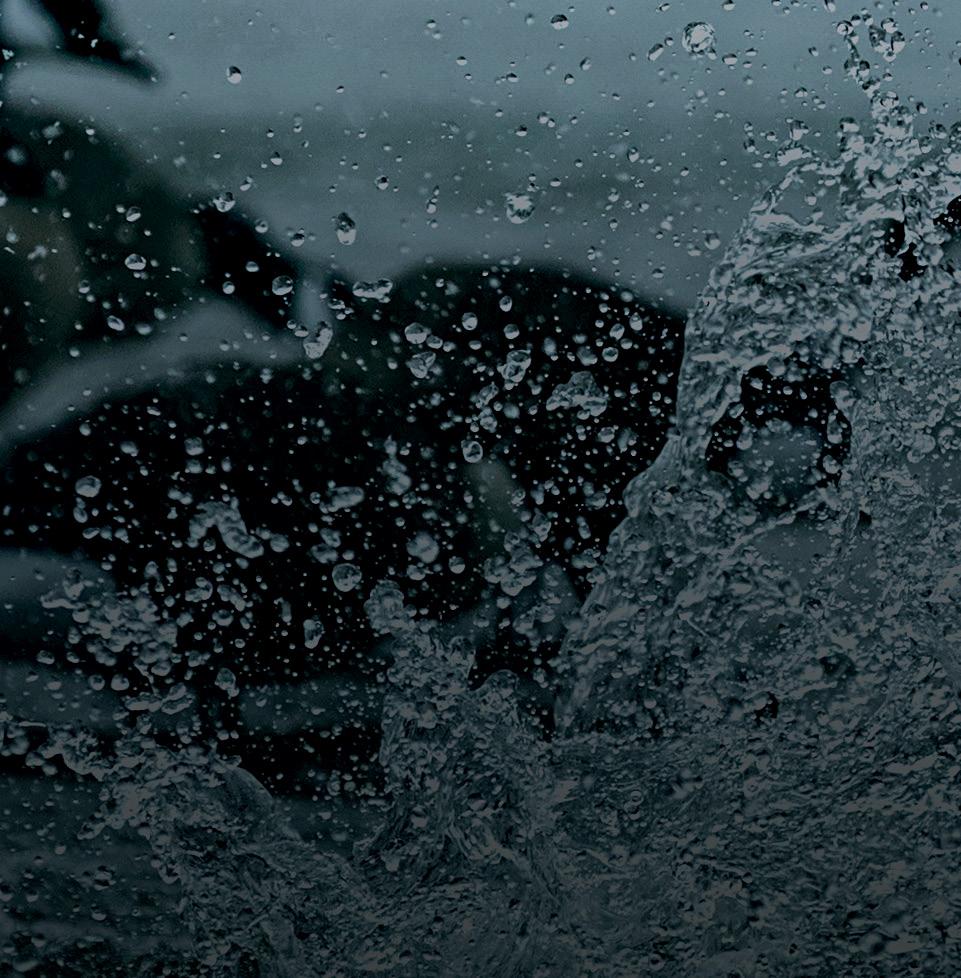








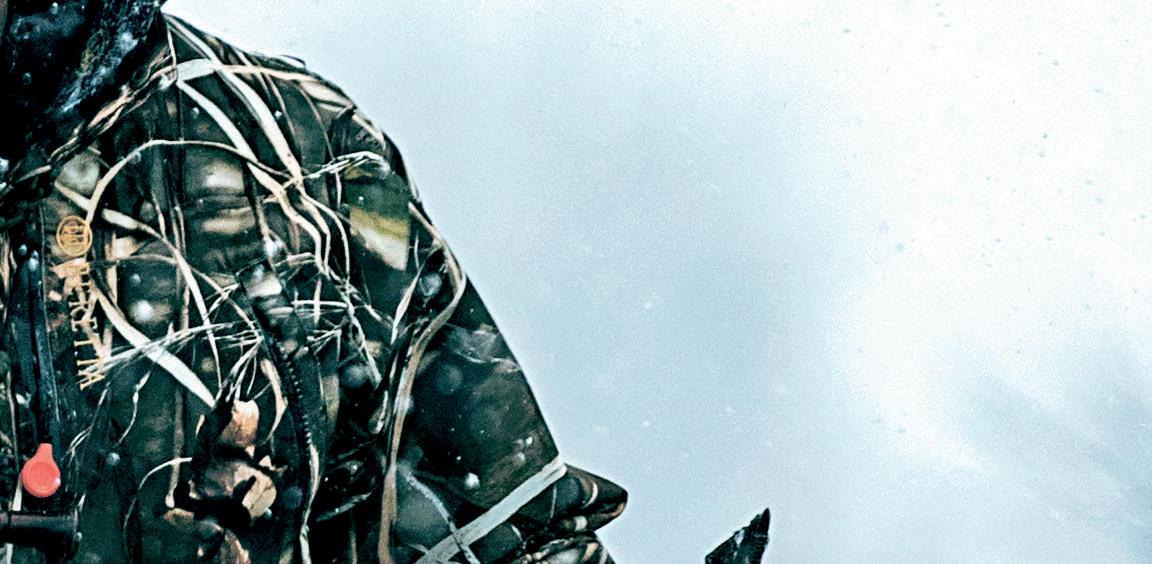












































































BY GORD PYZER

MOST FISH RELY on their sense of sight to capture prey, but they can also detect vibration and movement via the lateral line running along their sides and across their faces. This organ is so sensitive that fish such as walleye and bass can feel the hydro-acoustic trail of a cisco, shiner or baitfish that has just fled. Who hasn’t made a cast with a surface bait, for example, and been shocked when a fish smashed it the second it touched the water. And not only do fish use their lateral line to help capture prey, they also use it to communicate with each other, distinguish objects and avoid predators. But how exactly does this sixth sense work, and how can anglers use it to their advantage to catch more fish?
IDENTIFICATION SYSTEM
“It’s the neatest thing to take a magnifying glass and look at the sides of a fish,” says my good friend Steve Quinn, a renowned U.S. fisheries biologist. “You’ll see the small pores that run to the caudal fin and around the face of the fish. These little pores are openings to a liquid-filled canal that runs below the lateral line. They have hair cells that detect changes in the movement of water, giving them information to evade predators and find prey.”
Quinn says fish have to be relatively close to an object to feel it, typically using their eyes to spot it first, then sliding in behind it so they can switch over to their close-range lateral line identification system. Hydrodynamic stimuli such as the tail flap of a fleeing yellow perch sends out a current that remains in the water for some time, alerting fish via their lateral line.
“There nothing like it in the animal kingdom,” Quinn says. “It is a marvel of evolution how these creatures can feel these hidden currents. Fish are tuned in to any changes in the speed of the water around them.”
Quinn also points to evidence suggesting the lateral line is so sensitive that a predator fish can distinguish if a movement was made by the likes of a crayfish flapping its tail or an emerald shiner wagging its fins. He refers to this as a species-specific “signature.”
So, how can we exploit this remarkable sixth sense and incorporate it into our
daily fishing plans? On highly pressured waters, Quinn suggests being a contrarian, noting the reverberations from trendy lures can actually be detrimental to success if the fish associate them with an unpleasant experience, such as being caught and released. Instead, he says it’s better to present something different and slightly erratic.
“Fish always react to things that are a little offbeat,” Quinn explains. “They really relate to a change in the cadence of your lure, like a crankbait deflecting off a rock, a spinnerbait hitting a stick or a rattlebait that changes direction and alerts the fish that something is going on that might be valuable to investigate.”
While listening to Quinn, I was reminded of two other things. The first is that most predator fish use their senses of sight and feel in almost harmonious, lock-step combination. The second is that certain lure vibrations must inherently feel good and mimic their favourite foods. Think of the effectiveness of whirring in-line spinners and thumping paddletail swimbaits, for example. The fish never seem to get conditioned to avoid those particular lures, so they must be striking the perfect chord.
“They’re highly realistic,” Quinn says of such baits. “It gets back to those vortices that are left behind by prey fish. These soft-plastics on a jig head are coming very close to that range, so the fish are fooled. It is remarkable.” OC
FISHING EDITOR GORD PYZER MAKES THE CASE FOR USING LONG BAITS TO CATCH LARGE FISH ( SEE PAGE 66).
While the sense of hearing is integrated in a fish’s central nervous system, its role is remarkably subdued. Humans can hear frequencies of approximately 20 to 20,000 cycles, or hertz, per second. Fish, on the other hand, can generally only hear low frequencies from roughly 10 to 600 cycles. Fisheries scientist Steve Quinn says most rattling lures emit highfrequency sounds that resonate well with anglers shaking them in the bait shop, but go completely undetected by fish. Why? They simply can’t hear them.


BY SCOTT GARDNER
BY SCOTT GARDNER

SPEND MORE TIME FISHING WITH THESE SIMPLE GEAR MANAGEMENT
ONE OF MY goals as a fly angler is to get a little better every year. Since fly fishing doesn’t have a golf-like handicap system, however, there’s no official way to measure improvement, which is just as well. One area where I know I’m getting better, though, is managing my gear. Over the years, I’ve picked up many tips and hacks for maintaining and getting the most out of my rods, reels and lines. Here are a few of the handiest ideas.
If you want to instantly add five, even 10 feet to your cast, wash your fly line. Seriously. With time and use, lines get coated with silt, pollen and other stuff from the water, dust from closets, whatever’s on your hands and, if you practise casting in parks, grass stains. Taking off this gunk will instantly make your line float better, shoot better and reduce wear on your delicate rod guides. In the bad old days, anglers used products such as Armor All to condition their lines, but those can damage today’s modern coatings. Instead, you can effectively wash a line in about 15 minutes with just warm water and mild liquid soap. To avoid tangles, I use the simple and clever two-bucket method (to watch a video on how to do this, follow this link: www.outdoorcanada.ca/cleanflyline).
Backing is the light braided line that connects your fly line to the reel, extending the fly line’s length in case a fish makes a long run. In reality, that’s pretty rare. Mostly, backing acts as filler to increase the size of your spool so you can reel in line more quickly. For the best performance, you want to install just enough backing so that when the fly line is reeled all the way in, the reel is almost full. For years, I did this through a maddening process of trial and error, repeatedly unreeling line to add in or cut out backing until it fit correctly. Then I learned the reverse-measuring trick. First, wind the fly line onto the empty reel. Then crank backing onto the reel on top of the line until your spool is almost full. Cut it, and you’ve got the perfect length. Now unwind the backing and line onto their respective original spools, and reinstall them in the correct
order, with the fly line on top. I know this sounds laborious, but it’s guaranteed to work perfectly in one shot. Another hack: Rather than unwinding 150 or 200 yards of backing by hand, I run a bolt through the centre hole of the backing spool, then spin it with my electric drill.
I’ve busted three fly rods and witnessed several others taken out, all in predictable and preventable—and non-fishing—mishaps. As a result, I have developed strict protective protocols. First, never keep loose rods in a vehicle. They’re just too vulnerable, as I discovered years ago when a crate of camping stuff shifted and took out a beloved 5-weight. Instead, secure your rods in a rack or keep them in their protective cases. Next, use extreme caution around those ancient enemies of the fly rod: doors on buildings, and doors on vehicles, including trunks and tailgates.
Another excellent way to break a rod is by stumbling when getting in or out of a boat. To avoid that, hand your rod to someone or set it down in a safe place before making your move. When hiking with a rigged rod, meanwhile, hold it butt first. That may feel a little unnatural, but your body is much sturdier for clearing branches out of the way than your rod. And if you trip, you’ll almost certainly fall forward and instinctively put your arms out; it’s much better that the reel and butt hit the dirt instead of the rod tip.
Strictly speaking, none of this will make you a better fly angler—that requires practice and experience. But taking care of your gear does save on frustration, helping ensure you make the most of your precious time on the water. And that’s what it’s all about. OC
ASSOCIATE
EDITOR SCOTT
GARDNER KEEPS HIS FLY GEAR IN TOP SHAPE.
Want a fast, cheap and easy way to clean a grubby cork rod handle? Buff it with a wet Mr. Clean Magic Eraser (or generic alternative). The melamine sponge acts like ultra-fine sandpaper, making the cork look like new and provide a better grip.



Canadians are proud to live in a country that boasts some of the world’s most beautiful and expansive forests, and outdoor enthusiasts have been making the most of the wilderness in their backyard for generations.
That’s why conserving Canada’s forests for generations to come is critical and requires active management and significant planning.
Wendy Crosina, Director of Forest Sustainability at Weyerhaeuser, is based in Edmonton and is responsible for leading a variety of environmental stewardship roles for the company’s operations across Canada.
Crosina grew up in a logging camp in Northern BC and began her career as a tree planting supervisor with “boots on the ground, wandering in the forest and loving it.”
Before long, she became interested in the broader world of sustainable forest management, which includes the preservation of wildlife habitats and working with different stakeholders to manage the nation’s forests, including hunters, anglers, hikers, and other outdoor recreation enthusiasts.
“We talk to trappers, local communities, Indigenous leaders, and government [as a lot of operations exist on crown lands]” says Crosina. “All of that has to go into the planning of a [forest] tenure, some of which are as large as 1 million hectares.”
Forest management can be wide-
ranging, but integrates priorities like maintaining biodiversity, wildlife ecology, carbon climate solutions, and developing Indigenous relationships. Crosina says these are all related – a holistic approach to managing the forests of the future.
Governments mandate detailed 150to 200-year forest management plans that are re-evaluated every ten years to meet short, immediate, and long-term goals. And while less than one percent of Canadian forests are harvested annually, it is required by law that all forests harvested on public land are regenerated.
Crosina describes forestry as an agent of change, emulating natural disturbances, shepherding tree regeneration, maintaining a mosaic of forest ages across the country, managing habitats for species at risk, and integrating strategies to help manage wildfires.
She explains that the public plays an important role in sustainable forest management that safeguards the forest and its biodiversity, and citizen science can be “folded” into forest management planning.
Crosina has supported planning initiatives that integrate citizen science into promoting forest management practices.
In partnership with the Foothills Research Centre, she and a wider team helped introduce long-term species monitoring projects for local bear populations as part of their forest conservation efforts. Similar projects have been carried out for caribou
WE’RE ALWAYS LOOKING FOR NEW WAYS TO INNOVATE AND CAN’T BE AFRAID TO DO SO.
and fish populations, with hunters, anglers, mountain bikers and others on the ground recruited to help monitor the populations over time.
“We’re always looking for new ways to innovate and can’t be afraid to do so,” Crosina notes. Whether it’s finding new ways for citizens to work together with the forest sector or leveraging technology like drones to help with tree re-planting, on-the-ground foresters like Crosina are thinking creatively and innovatively about safeguarding the future of our forests.
Keeping our forests healthy today is critical for conserving their use for tomorrow’s outdoor recreationalists. And Canada’s forest sector ensures that this future is always top of mind.
BY BRAD FENSON

IF YOU’RE AIMING to take a black bear with your bow this fall, it’s important to be extra prepared. Not only must you have a firm understanding of bear anatomy, you also need to spend time practising, and consider where and how to place your set-up for the best shooting opportunities possible. Here’s a brief overview to get you started.
ANATOMY
Knowledge of bear anatomy helps ensures proper arrow placement for a lethal shot, which in turn makes for less tracking afterwards. Bears are built differently than ungulates, with the vitals further back in the chest cavity. So, rather than shooting at the front shoulder, you need to aim for the centre of the bear. Also consider a bear’s long belly hair, which makes the body appear deeper than it actually is.
You also need to know how to judge a boar from a sow. Boars tend to be bigger with long faces, while sows have a smaller stature and narrow, pointy faces. They also have smaller feet that tend to point slightly inward when they’re walking. As well, you must be able to gauge the bear’s age. Mature bears have a saggy belly, while younger bears look leaner and less rotund.
Practising with a 3D bear decoy is ideal for understanding shot angles. Start by shooting from a stand at a 20-metre target, then inspect where the arrow hits, as well as determine where it would have exited. Make notes on how high you need to aim to get the ideal exit point through the vitals. Some archers prefer a ground blind for bears, since there’s no angle to worry about and a better chance of a clean pass-through. Even if you choose a ground blind, however, it’s still a good idea to practise shooting and be sure of the entry and exit points.
Once you decide on a stand or blind, shoot the 3D target at various angles. This exercise is mostly about paying attention to the front legs. A black bear in a dark forest can be difficult to see clearly—it may seem like the bear is broadside or quartering, but it’s easy to make a mistake. Bears are agile creatures, and they can twist and turn into stances that are quite deceiving.
A slightly quartering away shot is always good, but if not perfectly placed, it
can result in no exit, with the arrow lodged in the bear’s far shoulder. Pay attention to the front legs to see if they are lined up with, or offset from, the body. This will tell you where the vitals and far shoulder are located.
Bowhunting bears from a treestand offers improved visibility into the surrounding habitat. If you opt for a stand, first take into account whether you’re a left- or right-handed shooter. Then offset the stand accordingly to allow for an easy, unobstructed draw and comfortable aiming angle. Crossbow hunters should also consider the angles when incorporating shooting sticks, or a rest.
While a taller stand allows you to see more, it also requires a steeper shot angle. That can make it more challenging to take out both of a bear’s lungs to ensure a lethal shot. A lower stand at approximately eight to 10 feet high, on the other hand, reduces the angle and makes lethal shots easier.
Also consider where you’ll place your bait when selecting a stand location. That way, you can control the shot distance and angle, and ensure there will be ample time to field judge.
Set the stage around your stand or blind and bait barrel with obstacles that force the bear to turn broadside, or otherwise offer the best shot. Logs, rails or a makeshift corral can prevent bears from hiding behind cover (or even lying behind the barrel) when checking out the food.
For field judging, your barrel can offer a good reference point for determining the size of a bear. If a bear standing on all four feet is as tall as a 55-gallon drum, for example, it’s an extra-large animal.
Bears typically knock the barrel over, however, so be sure to have an alternate reference point. Options include erecting an actual measuring stick, or tying flagging tape to nearby trees at specific heights. It’s just one more piece of the puzzle to ensure you harvest the bear you want, in the most efficient way possible. OC
BRAD FENSON HUNTS BEARS WITH BOTH CROSSBOWS AND COMPOUNDS.


BY KEN BAILEY


WHEN I STARTED waterfowling as a teenager, my possibles bag was a canvas pouch I bought at the local army surplus store. I dumped my shells, Faulk’s calls and a chocolate bar in it, then prayed everything would stay dry. As for my licence, that was crammed into my wallet, which in turn was stuffed into my jeans. God forbid I needed anything else, which I often did. In those cases, I was “SOL,” as my dad would say.
How times have changed. Today, waterfowl hunters have superbly designed, customizable blind bags that are waterproof, durable and equipped with an assortment of compartments for every need. I have two bags ready to go each fall, one for field hunting and one for hunting on the water. Much of my musthave gear is duplicated between the two, but there are some items I only carry on the water. Not sure what to bring along on your own hunts? Here’s my checklist of essentials.
FIELD & WATER HUNTS
Along with my hunting and firearms licences kept dry and readily accessible in a sealable bag, here is what my blind bag contains, whether I’m hunting in fields or on the water.
• SHOTSHELLS Typically, I bring two boxes of shells. That’s generally more than I need, but you never know.
• DUCK STRAP A great device for carrying multiple birds, a duck strap also comes in handy when taking post-hunt photos.
• CALLS I carry a wider assortment of calls when hunting the water because of the diversity of species I might encounter.
• EARPLUGS It’s a case of too little, too late for my hearing, but I’ve gotten better about wearing earplugs. My advice? Always wear them when waterfowl hunting.
• CHOKE TUBES & WRENCH It’s not often I’ll switch chokes mid-hunt, but when those occasions arise, it’s good to have options.
• CELL PHONE It performs double-duty for making emergency calls and taking pictures, but if your phone rings mid-hunt, you’re obligated to buy breakfast.
• HEADLAMP A headlamp is indispensable for freeing your hands to set out decoys, build blinds and perform numerous other tasks in the dark.
• SUNGLASSES To ease eye strain on bright days, sunglasses are essential. Many blind bags have specific protective pouches for them.
• MULTI-TOOL A multi-tool has near endless uses, so don’t leave home without one.
• FACE MASK OR FACE PAINT Whether you prefer to wear a mask or use camo paint,
hiding your shiny mug can be a game-saver some days.
• SNACKS & WATER A granola bar and a bottle of water can seem like lifesavers on those days when hunts last longer than expected.
• TOILET PAPER It’s always a good idea to bring along a wad of “marsh money,” as some hunters call it.
From wind and waves to fog and engine trouble, the risks quickly add up when you hunt from boats on big water. You just never know when you might become stranded for several hours, or even overnight. Some risks are preventable or at least manageable, if you’re well-organized. Like all insurance, you hope to never have to use it, but when bad things happen, that extra piece of gear can make all the difference.
• FLASHLIGHT In addition to a headlamp, a handheld light is ideal for working on motors, scanning shorelines and a multitude of other chores. Carry spare batteries.
• COMPASS & GPS It’s easy to get turned around in the dark or fog. Always carry navigation tools and know how to use them.
• WARM GLOVES, TOQUE & EXTRA SOCKS Getting wet is almost inevitable when you’re on the water, and in cool weather that can lead to hypothermia. Have gloves, a toque and dry socks at the ready, and throw in a couple of chemical hand-warmers.
• LIGHTER OR MATCHES If you become stranded for even a few hours on a cold day, a fire will help keep you warm and comfortable.
• FIRST-AID KIT When you can’t easily get back to your vehicle and head home, a simple first-aid kit is invaluable for dealing with a range of cuts and other ailments.
• PORTABLE STOVE Even when everything goes as planned, there’s nothing better than a steaming hot cup of coffee or soup to warm your innards on a cold October morning.
• BINOCULARS One of the rewarding aspects of hunting large wetlands is the chance to view a diversity of wildlife. Binos also help in identifying where and how ducks are moving. OC
BAILEY
SEE PAGE 38, FOR HUNTING EDITOR KEN BAILEY’S SPECKLEBELLY TIPS. KEN







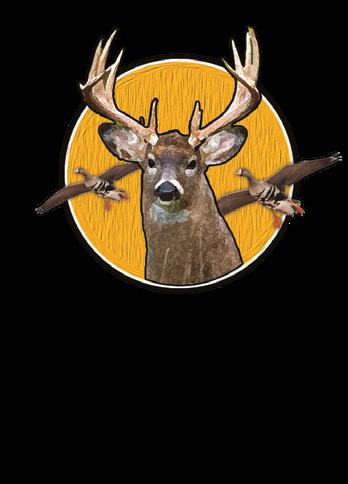
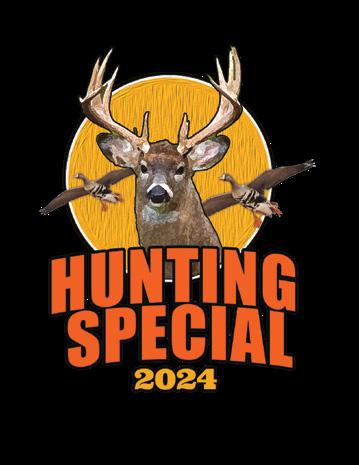

Are you wise about whitetails? Take our exclusive quiz and put your deer smarts to the test
TO BE A SUCCESSFUL hunter, it's crucial to know as much as possible about your quarry—and that is especially the case when it comes to pursuing wily white-tailed bucks. Covering everything from deer biology to behaviour, our 35-question quiz aims to gauge your whitetail IQ and get you pumped for the hunts ahead this season. Put on your thinking caps and enjoy. The correct answers are listed on page 37, but try not to peek!

HOW OLD IS A BUCK WHEN CONSIDERED FULLY GROWN?


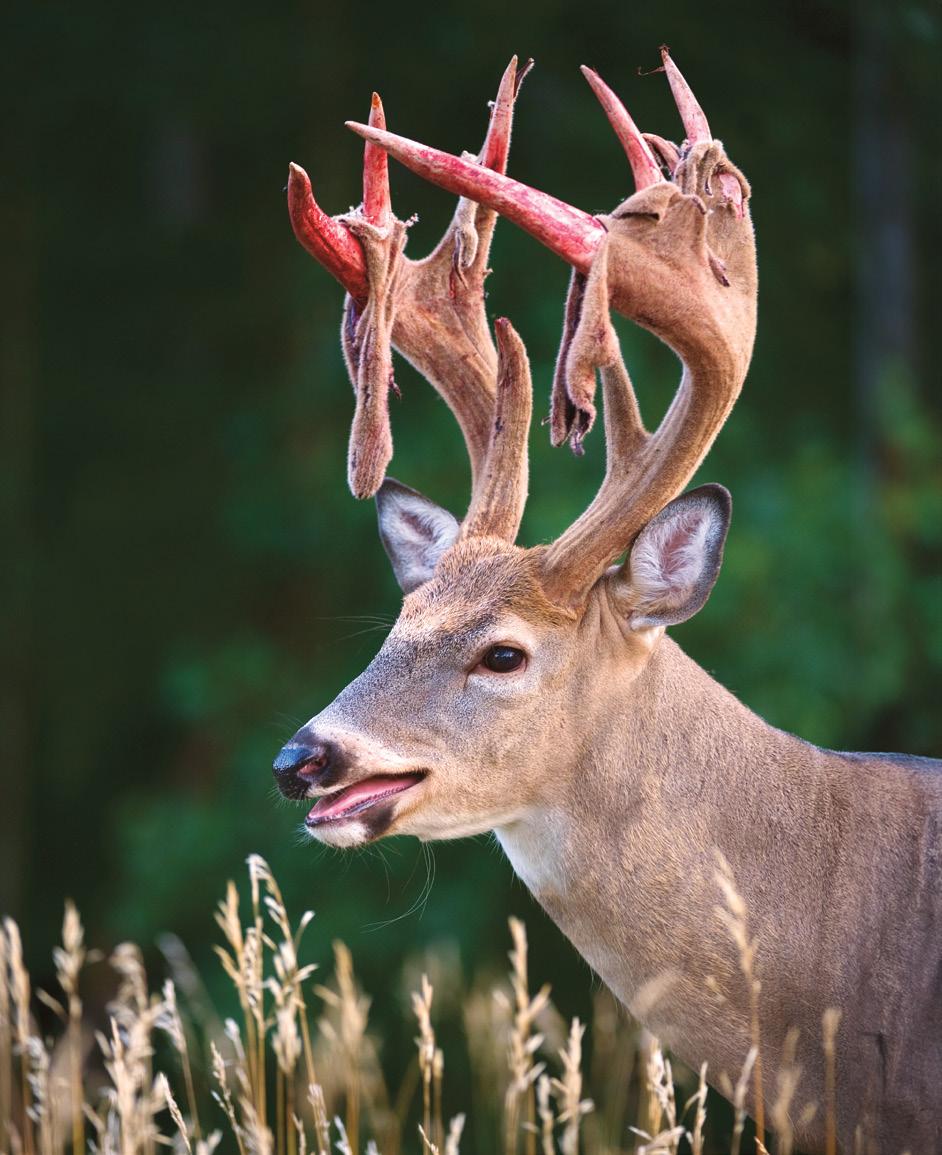
ANTLER VELVET SHEDDING IS A PAINLESS PROCESS THAT USUALLY TAKES APPROXIMATELY 24 HOURS. IT IS TRIGGERED BY:
A] The drop in temperature
B] Changing of the colour of the leaves
C] Decreasing daylight
D] The first doe coming into heat
E] Sparring
3} BUCKS SOMETIMES EAT THEIR SHED ANTLER VELVET.

5} LONGER BROW TINES BENEFIT A BUCK WHEN IT COMES TO FIGHTING AND SUCCESSFUL DOMINANCE.
4} A SMOOTH ROUND HOLE SOMETIMES FOUND IN A MATURE BUCK’S ANTLER BEAM IS MOST OFTEN CAUSED BY:
A] Damage from bumping the growing tissue
B] A botfly larva
C] Protein insufficiencies
D] A lack of calcium
6 }


7} MATURE BUCKS ARE MORE LIKELY TO BED AT THE BOTTOM OF FOREST RIDGES THAN NEAR THE TOP.
THE WHITETAIL’S TOP FALL FOOD SOURCE IN EASTERN CANADA IS:
A] Sumac
B] Clover fields
C] Acorns
D] Cornfields
E] Cut soybean


BIG
10
ESTABLISHING A BUCK DOMINANCE HIERARCHY PRIOR TO THE RUT:
A] Results in more bucks leaving their home range
B] Results in more fights during the rut
C] Results in fewer fights during the rut
D] Attracts more does to the area
11
DROP-TINES ARE MOST OFTEN THE RESULT OF:
A] Genetics
B] A highprotein diet
C] Age
D] Injury during antler growth

2024


12} THE BIGGEST ANTLERED BUCK WILL ALWAYS WIN THE FIGHT FOR THE RIGHT TO BREED.
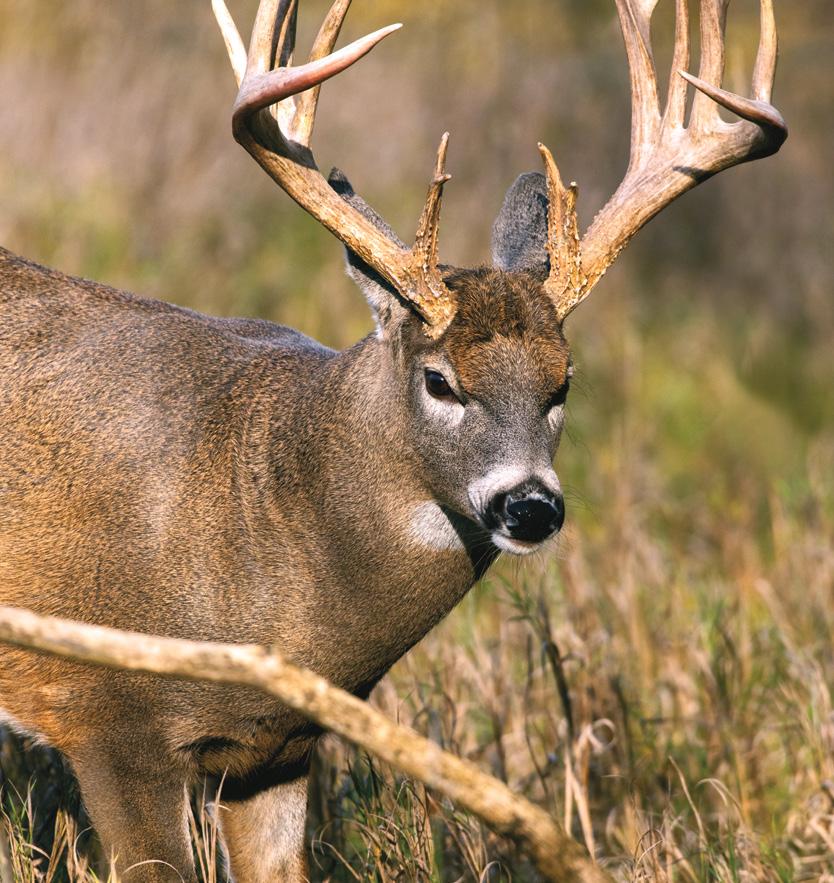

13 }
B] DEER WILL COME OUT TO FEED EARLIER IN THE EVENING ON CLOUDY, DARKER DAYS. A DEER WILL FLASH ITS WHITE TAIL TO:

15 } 14
A] Distract predators
B] Show it is about to flee from a perceived threat
C] Offer a target for a predator to grab instead of its head
WHEN STARTLED AT CLOSE RANGE, BUCKS OFTEN FLEE WITHOUT FLASHING THEIR TAIL BECAUSE:
A] They’re not concerned about alerting other deer to danger
B] Their only concern is to escape the nearby threat
C] Bucks don’t flash their tails
D] They’re too lazy
D] To warn nearby deer there is danger afoot 16
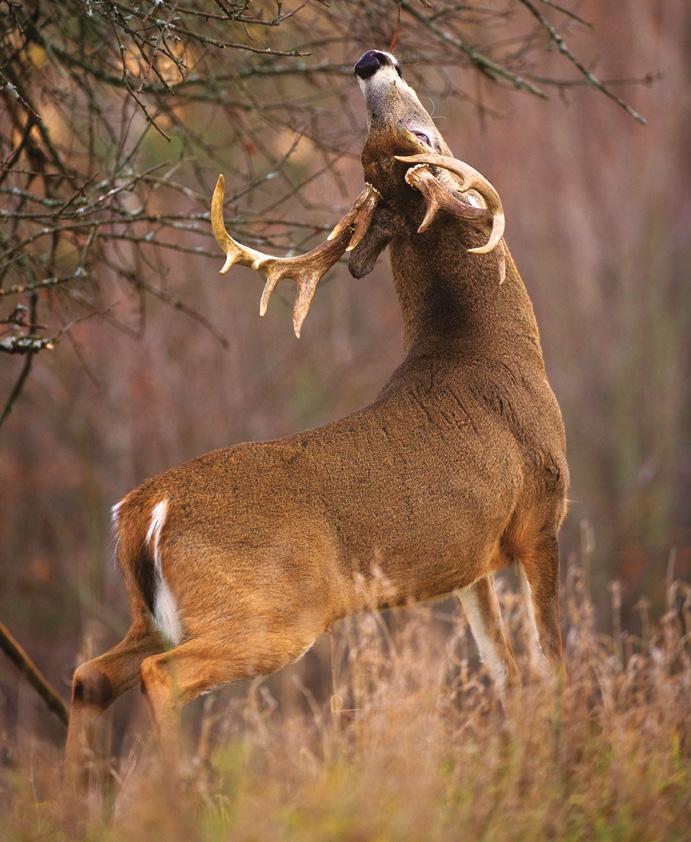
A] Grab a bite of their favourite tree
B] Deposit scent to mark their territory and attract does
C] Work their thickening neck muscles for the rut
D] Show off their antlers
E] All of the above

17 }
THROUGHOUT CANADA, THE WHITETAIL RUT OCCURS DURING:
A] The last week of October
B] The first week of November
C] Mid-November
D] Late-November
A] Trees that give them shade
B] Cottonwood river bottoms bordering croplands
C] High knolls providing the best lookout when they bed down D] Wetlands
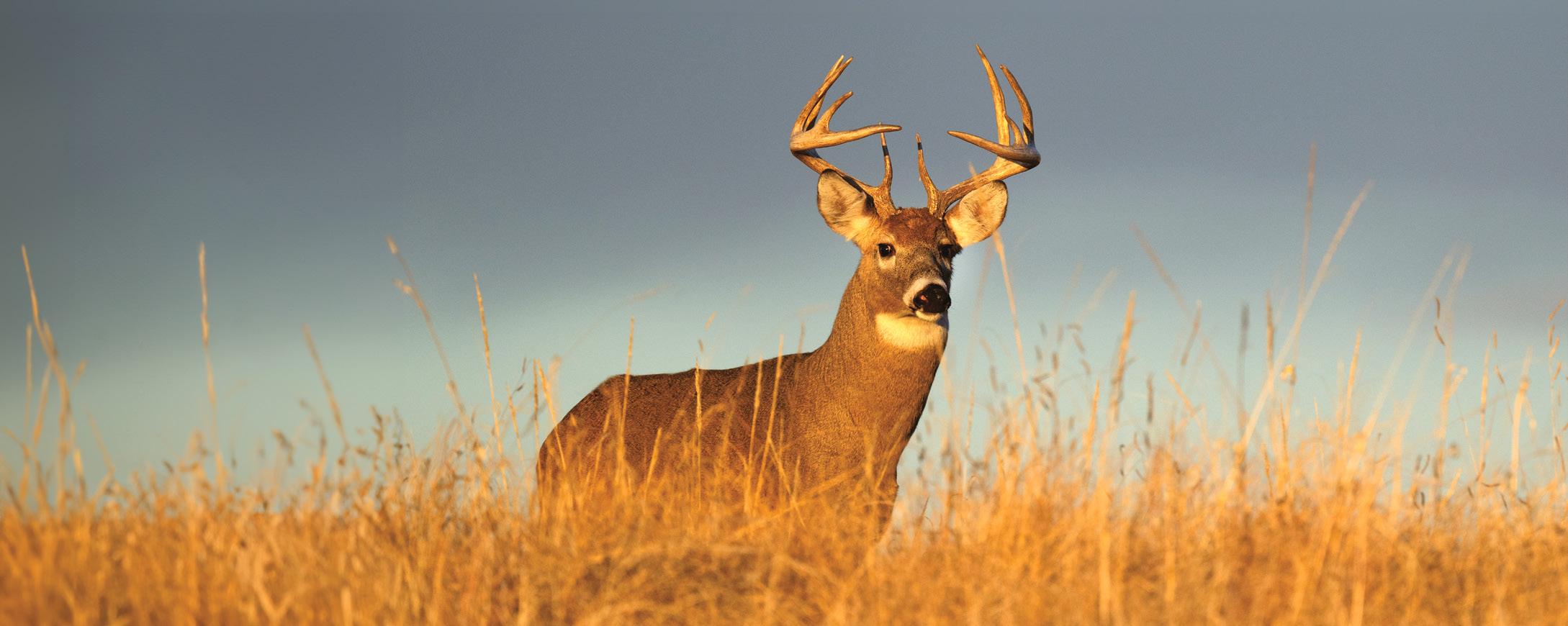
19} HOW MANY VOCALIZATIONS DO WHITETAILS HAVE?
2
4
8
10
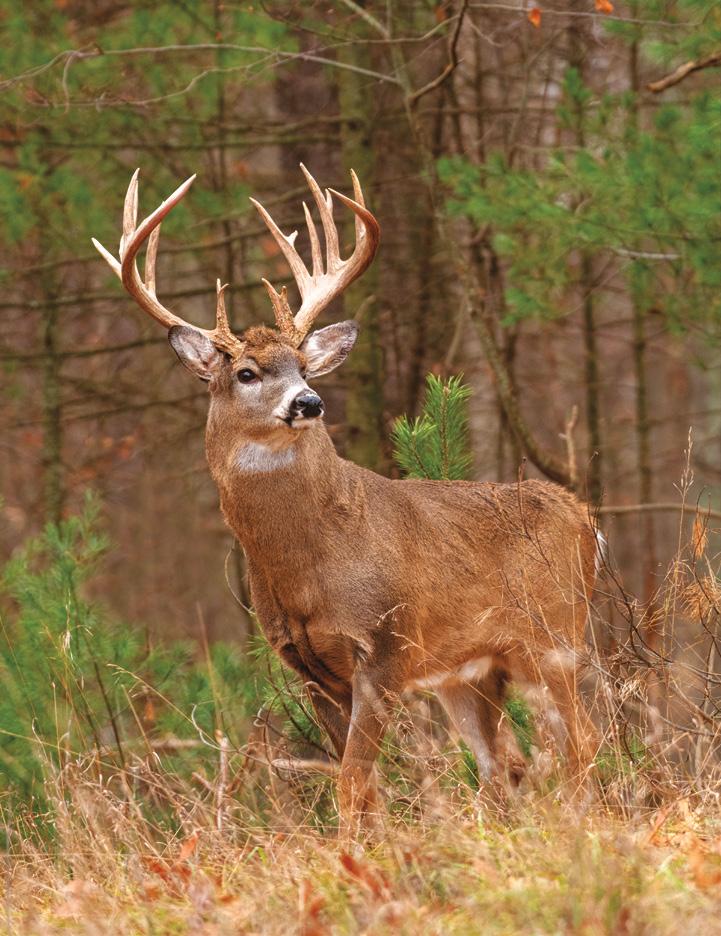
20 }
YOU CAN DIFFERENTIATE A MATURE BUCK FROM A YOUNG BUCK BY:

A] A dip in its back line, and a slight belly sag
B] A swollen neck
C] Significant antler mass
D] A more pronounced chest brisket
E] All of the above
TO ENSURE IT’S SAFE BEFORE PURSUING A DOE, AN EXPERIENCED MATURE BUCK WILL OFTEN HOLD UP IN THE SHADOWS UNTIL THE DOE EMERGES.

THE MAIN DEER COMMUNICATION HUB OF THE RUT IS:
A] A fresh rub
B] A fresh scrape
C] Where their favourite food source is located
D] Their daytime bedding area
A] Tarsal
24 } { 22 } 18 WHEN SEEKING PRAIRIE BRUISERS, BE ON THE LOOKOUT FOR:
B] Forehead
C] Mammary
D] Pre-orbital WHICH IS NOT A GLAND USED BY BUCKS DURING THE RUT?
BUCKS ARE MORE LIKELY TO REWORK A:




25] THE INHALE/EXHALE SNORT-WHEEZE CALL IS MADE WHEN A DEER IS:
A] Warning others of danger
B] Trying to clear its sinuses
C] Agitated and threatening a rival
D] Alarmed and about to flee

AFTER TASTING THE URINE OF A DOE THEY’RE TRACKING, BUCKS LIP CURL TO:
YOU CAN TELL A DOE HAS BEEN SUCCESSFULLY BRED WHEN: 30
A] She runs off and leaves the buck
B] She lays down
C] She squats to urinate
D] She nuzzles the buck
E] She bleats loudly
{26} {27}
UNLESS BUMPED OFF BY A LARGER BUCK, A MALE WILL TEND A DOE FOR APPROXIMATELY:
A] Verify if the doe is in heat
B] Make a threatening gesture to other males
C] Vent some of their testosterone rutting energy
D] Cleanse their palate
E] All of the above
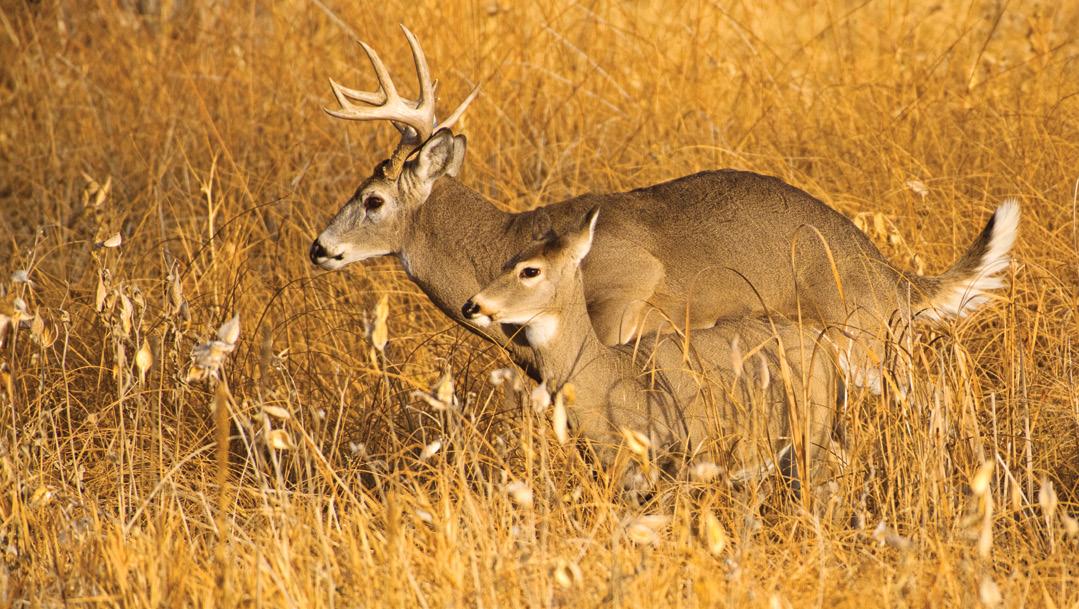

STANDS OF ACORN-PRODUCING OAKS IN BIG TIMBER NEXT TO A BEDDING AREA ARE IDEAL FOR HUNTING:
A] At dawn B] At midday C] At dusk D] Anytime

THE SIZE AND CONFIGURATION OF ANTLERS IS ONLY PASSED ON TO A BUCK FAWN FROM HIS FATHER’S GENETICS
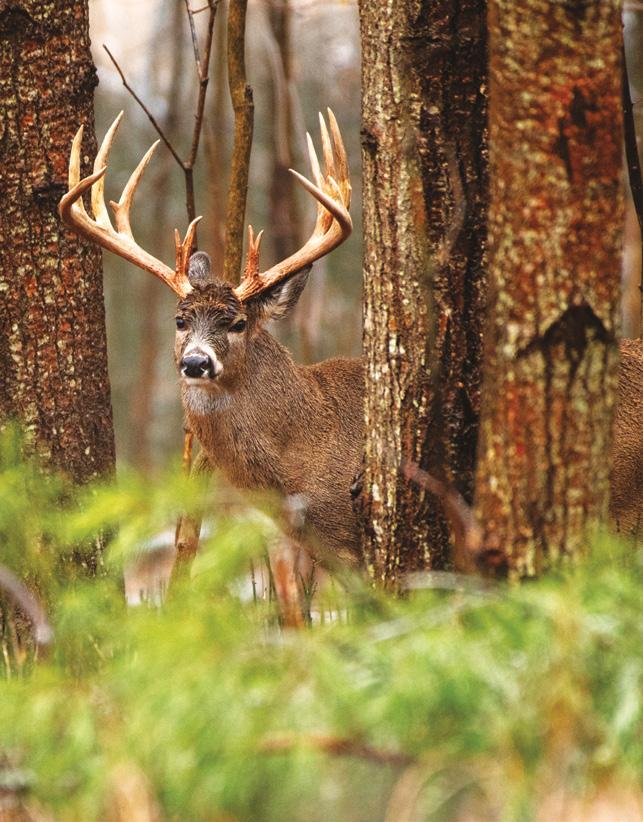
MATURE BUCKS DO NOT EAT DURING THE RUT.
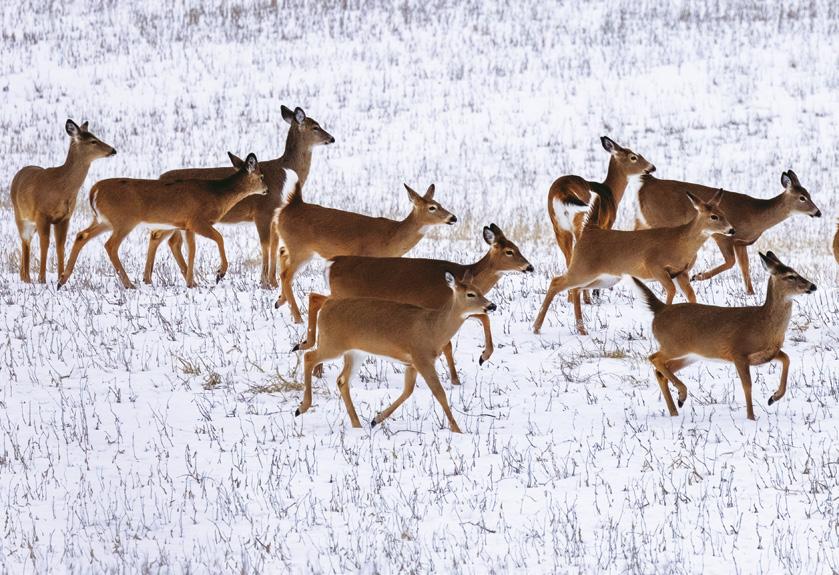
SOME DOE FAWNS ARE SUCCESSFULLY BRED DURING THEIR

THE BEST LATE-SEASON OPPORTUNITY TO SEE A BIG BUCK IS:
A] Before a snowstorm
B] During a snowstorm
C] During a high pressure/sunny morning
D] During an unseasonably warm morning
E] All of the above
1. B] 4½
2. C] Decreasing daylight
3. A] True
4. B] A botfly larva
5. A] True
6. B] False
7. B] False
8 C] Acorns
9. B] False
10. C] Results in fewer fights during the rut
11 A] Genetics
12. B] False
13. B] False
14. D] To warn nearby deer there is danger afoot
15. B] Their only concern is to escape the nearby threat
16 B] Deposit scent to mark their territory and attract does
17. C] Mid-November
IF THEY REMAIN HEALTHY, MATURE BUCKS WILL OFTEN SHED THEIR ANTLERS ON OR NEAR THE SAME DAY EACH WINTER.

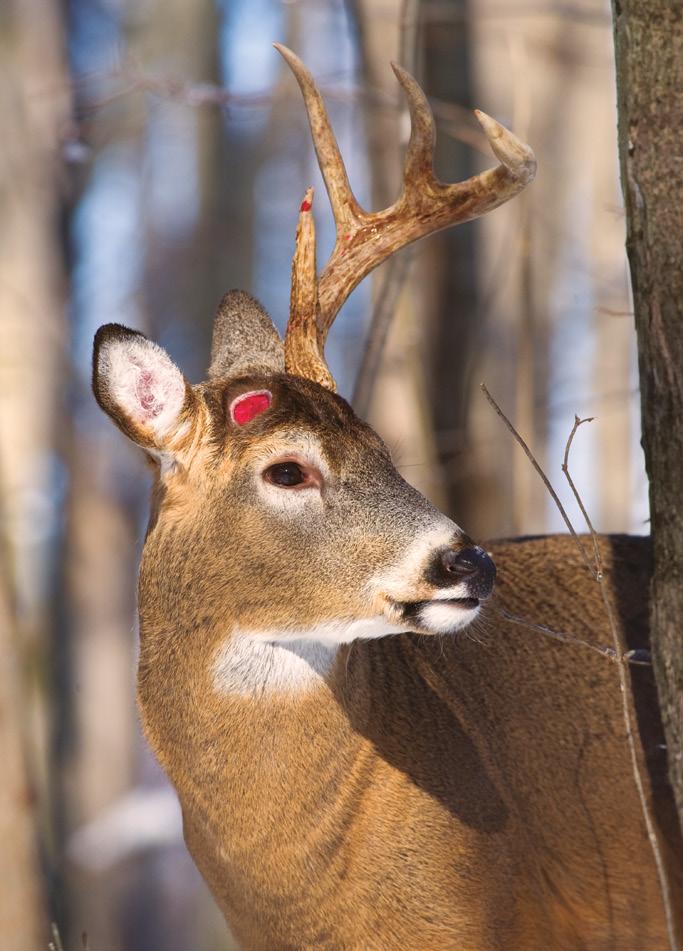
18. B] Cottonwood river bottoms bordering croplands
19. C] 8
20 E] All of the above
21. A] True
22. B] A fresh scrape
23. C] Mammary
24. B] Scrape
25 C] Agitated and threatening a rival
26. B] 2 days
27. B] 10
28. A] Verify if the doe is in heat
29. D] Anytime
30. C] She squats to urinate
31. B] False
32. B] False
33. A] True
34. A] Before a snowstorm
35. A] True
YOUR DEER IQ
So, are you a whitetail whiz or in need of some serious deer lessons? Tally up your correct answers and find out!
0 TO 9: Find yourself a whitetail mentor 10 TO 19: Spend much more time afield 20 TO 29: You’ll likely cut a tag this fall 30 TO 35: You’re as smart as an old buck




Renowned as excellent table fare, the greater white-fronted goose has expanded its western range, and the hunting opportunities in the process
BY KEN BAILEY
Ken Bailey says specks require their own strategy
KNOWN TO HUNTERS more popularly as “specklebellies” or simply “specks,” greater white-fronted geese are undoubtedly the least hunted—but most desirable—of our prairie geese. They were all but unheard of across much of Alberta 30 years ago, when their narrow fall migratory flyway confined them to west-central Saskatchewan and the slimmest eastern edge of Alberta. In fact, when I guided waterfowl hunters an hour southeast of Edmonton in the early-1990s, we would seldom see, much less hunt, specklebellies. But that’s all changed now.
Over the last few decades, specklebelly populations have grown and their migratory path has expanded, giving greater numbers of hunters the opportunity to hunt them. Since specks cannot be hunted effectively using tried-and-true Canada goose strategies, however, success was limited at first. But with time and experience, more and more hunters have come to better understand how to fool these notoriously wary birds.
Recently, I had the opportunity to sit down with two very experienced specklebelly hunters, well-known Alberta outfitter Claudio Ongaro, and Mark DesRoches, an outfitter and travelling hunter who has taken all 41 of North America’s waterfowl species. They let me in on the tactics they’ve developed over the years to consistently and successfully limit out on these tasty birds. Here are their key pointers for upping your own specklebelly game.


WHITE-FRONTED GEESE behave very differently than Canadas and, to a lesser extent, snow geese. They’re the first geese to leave the roost in the morning, often showing up with mallards before first light. That means your best opportunities will come in the first half-hour to hour after legal light. Just know their suspicious nature makes them the most difficult of all our geese species to consistently kill, so you can’t afford to make mistakes.
One upside is they'll often come out in family groups first thing in the morning, providing successive waves of shooting opportunities. On particularly calm and clear mornings, however, they’ll often come out all at once, and your chance to shoot can be over in minutes.
The best mornings are sunny and windy—the sun creates shadows to help keep you hidden, while the wind keeps the geese low and on course. The challenge, however, is that morning winds tend to swing, so your onceperfect decoy spread can become a barrier rather than an attractant. For that reason, some prefer hunting specks in the afternoon, when the wind direction tends to be more consistent. Another advantage to afternoon shoots is that specks don’t always day-roost together, leading to smaller flights and extended hunts.
Early in the season, specks tend to fly in family groups, but as the fall progresses, they’ll stage and feed in progressively larger flocks. These geese are an early migrant to the prairies, and usually move on through by mid-October. And while Canada geese prefer to avoid snow geese, specks don’t mind them; it’s not unusual to have mixed hunts of the two species. (Also see “The specs on specks” on page 44.)
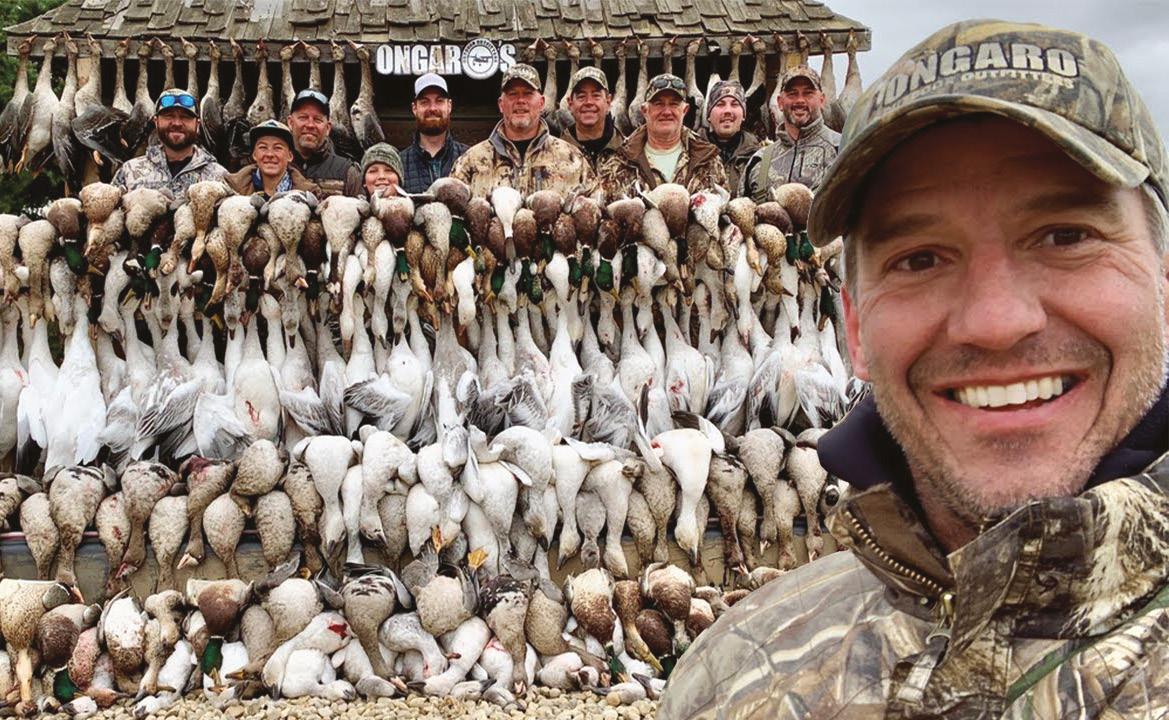

Claudio Ongaro (top) and Mark DesRoches are speck experts
AS WITH HUNTING all geese, scouting is fundamental to success, but it’s not enough just to see birds feeding in a field. If they’re broadly spread out, it can mean the field has been picked pretty clean, and there’s a risk the geese may not return the next morning. Unlike snow geese, specks are not as prone to jumping fields, but you want to do everything you can to avoid
a here-today-gone-tomorrow scenario. So, watch them carefully until dark.
Be aware of where they’re roosting, too, and the prevailing winds around the roost. Depending on the wind, shooting a field within a kilometre and a half of the roost can mean the geese will hear your opening volley, making them unlikely to follow the first birds in.
SPECKS ARE RENOWNED for being cautious and easily spooked, so hunters need to be well-concealed. Wherever possible, set your blind next to or within natural cover; along field edges is the best option if the birds are feeding close enough you can pull them in. A-frame blinds are popular, especially with large groups of hunters. When properly camouflaged, they can be effective in any situation, even in the middle of bald fields. These days, more and more hunters, especially when they’re in groups of four or less, hunt from willow blinds. These blinds were common in the 1980s and ’90s, but lost favour when goose chairs, then layout blinds followed by A-frames each took their turn as the preferred option. Hunters are
once again discovering how effective willow blinds can be, however, especially when the blinds are clad in camo netting under a dense layer of cut willow. Both A-frames and willow blinds have the added advantage of allowing hunters to sit while waiting for geese. Then it’s simply a matter of standing to shoot once the birds arrive.
When you’re shooting from scrubby cover, layout blinds are an effective option, but they’re the most difficult blinds to shoot from, especially for older hunters. That’s because you must open the doors from a nearly horizontal position, then do a sit-up to get into shooting position. That extra second or two means you’ll occasionally be a little late on the birds. You’re also somewhat restricted in how far you can swing to shoot, especially to your gun side. Still, there’s no
denying how effective the low profile can be when it comes to fooling approaching geese.
When specklebellies are feeding in a field where snow geese are also present, another option is to dress in white and lay down among snow decoys (see next section). This tactic isn’t much fun on wet days or in muddy fields, but it’s not as confining as layout blinds, and you’ll all but disappear among the sea of white.
Aside from the first and last hour of the day, specks can be very difficult to fool if your blind is at the upwind end of your decoys and you’re expecting the birds to fly straight toward you. The answer is to set your choice of blind downwind and to one side of your spread, where you can side-shoot landing birds as they fly past.

Layout blinds are tougher to shoot from, but highly effective


IF GOOD COVER is the most important factor in fooling whitefronted geese, effective decoying is the ticket for ensuring they finish properly in your kill zone. These geese are particular about when and where they’ll land; they generally won’t fly into Canada goose decoys, but they will land among snows. Snow decoys can help fill out your spread, and they’re especially helpful in the early morning and on foggy days, as specks will be able to see them from afar. Since approaching specks won’t land in front of snow geese, just be sure to keep your snow dekes on the upwind end of your spread. As with hunting snow geese, the more decoys in your spread, the

better. Six or seven dozen decoys is usually sufficient, but if you have more, use them. Full-bodies, shells and silhouettes will all work, but Claudio Ongaro relies almost exclusively on fully flocked speck silhouettes. They’re not only affordable, he says, but also easy to set up and take down, especially when you have a large spread. If Ongaro
expects snow geese to also show up, he’ll supplement his spread with several hundred windsock snow decoys and, occasionally, some full-bodied snow dekes. Specks respond well to motion, so flagging is beneficial, especially in low-light conditions. Electronic flyer decoys can also be effective, but as with Canada geese, specks
VERACITY ® RIFLESCOPE 5-25X50MM
The finest in premium, light-gathering scopes. This is time-proven Burris engineering that won’t fail when it’s go-time, combined with state-of-the-art refinements like 5x zoom and front focal plane reticles that deliver excellent target acquisition and a closer look at the big, bright picture.




Large numbers of silhouette decoys are easy to set up
will shy away from spinning-wing duck decoys.
Much as you would create for other geese, U- or V-shaped decoy spreads will do the trick just fine. Leave a wide kill zone, but sprinkle the open area with family groups of speck decoys.

SPECKS ARE WIDELY acknowledged as the tastiest of our geese. They were once often described as the “ribeye of the sky,” in fact, before sandhill cranes assumed that honour. It’s difficult to go wrong when using any method to prepare a specklebelly for the table, provided you first thoroughly wash and dry the bird, then ensure you don’t cook it beyond medium-rare.
Paired with your favourite beef or venison marinade or rub, or simply a little salt and pepper, boneless speck breasts
Slow-cook the legs and thighs for the most tender and tasty results
can be grilled to medium-rare perfection. The legs and thighs, meanwhile, are best when slow-cooked, much as you would with pork ribs, until they are fall-off-the-bone tender.
For those who prefer to roast their geese, cook specks at 425°F for 17 to 20 minutes per pound, or until the internal temperature reaches 165°F. Your favourite stuffing will make a great addition, but again, these flavourful birds will satisfy even the most discriminating palate if seasoned with no more than salt and pepper.




Trick incoming specks that it's safe to land by making calls
WHITE-FRONTED GEESE don’t vocalize nearly as much as Canada geese, and most hunters are unfamiliar with their vocabulary. Basically, their call while flying has been described as sounding like laughing, with a high-pitched yelp of two to three notes. Get yourself a dedicated specklebelly call and watch online videos to practice if you’re new to the game.
Specks can be difficult to turn by calling, as they’re less prone to changing their minds than Canadas. It still pays to call, however, giving incoming birds the confidence that it’s safe to land. And don’t worry if you can’t sing a specklebelly’s song perfectly, says Mark DesRoches, as there’s really no wrong sound when it comes to these geese.

GREATER WHITE-FRONTED geese are medium-sized Arctic nesters that breed from the western shore of Hudson Bay to Alaska, and winter predominantly along the Gulf Coast of Louisiana and Texas, as well as in the Mississippi Alluvial Valley. Their proper common name is a tribute to their white facial patch, but the hunting community generally refers to them as “specklebellies” or “specks,” owing to the dark blotches and bars on the breasts of adult birds. The rest of their plumage is gray-brown, with white markings on the tail, rump and flanks; juvenile birds have rather drab brownish feathering. Adults have distinctive orange legs and pinkish bills, while juveniles have yellowish legs and bills.
AS MEDIUM-SIZED geese, specks are not as hard to kill as large Canadas, but it still pays to shoot the best ammunition you can afford. Ongaro swears by #2 loads of HEVI-Shot’s HEVIHammer—a premium, but relatively affordable, load—for all his goose hunts. He also recommends shooting through improved cylinder chokes. That flies somewhat in the face of tradition, which suggests using a tighter choke, but when you’ve guided hunters to as many geese as Ongaro has, I’d suggest his advice is worth heeding. OC
HUNTING EDITOR KEN BAILEY PLANS TO HUNT SPECKLEBELLIES MORE THIS COMING SEASON.
As with most Arctic-nesting geese, the speck population has grown significantly in recent decades. In the early 1970s, the total population was estimated at 500,000 birds; by 2010, numbers had climbed to around 3.5 million. Since then, there’s been a short-term decline to approximately 2.5 million birds, driven by poor breeding success similar to that of other Arctic-nesting geese.
The specklebelly’s fall migratory path has changed over time, largely due to agricultural changes on their wintering grounds. In the early 1990s, they rarely ventured to central Alberta in the fall, but today they regularly visit that region across to eastern Saskatchewan, where grain and pulse crops provide an important food source.

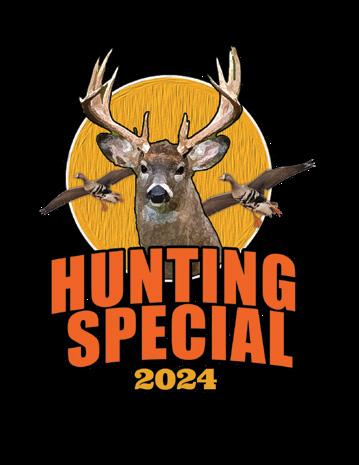
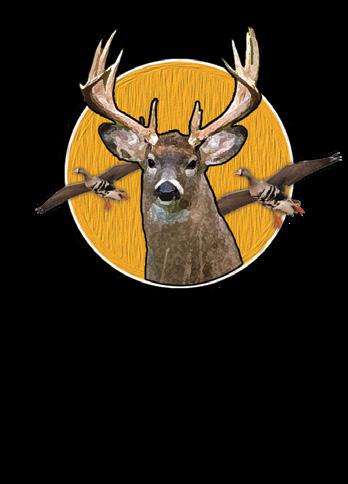


BY L.W. OAKLEY
For this old hunter, one final foray afield promised to last forever in the great beyond
THE CAMP WAS empty as the old man watched the November dawn approach over the trees. The others had already left in the dark by flashlight. They were waiting quietly now for the hunt to begin near granite ridges, green swamps and game trails. He had shown most of them how to find those places, where to stand, which way to look, and when to shoot. Then as day broke, he set the dogs loose to run deer to them, as he had for many others before their time.
He was too old now himself to go to the woods and hunt. His legs had become weak first. Then his eyes went. He tried to keep hunting, but felt tired all the time. That’s when he knew something was eating away at him. He didn’t need a doctor to tell him that. So, he stayed behind at camp.
It was his job to keep the fire going and clean up and cook lunch before the men returned from hunting. He emptied the warm bacon grease from the cast iron fry pan into a jar. Then he lifted the metal coffee pot with his


name scratched onto the side to see if there was one more cup left. He sat down at the big wooden table in the middle of the room and stared at the crumbs and ashtrays filled with cigarette butts while he drank his coffee.
The old man thought about how his name would be scratched on the back page of a newspaper one day, then on a piece of stone. He didn’t care about that. He just hoped someone remembered him when they looked at the scratches on the coffee pot.
It was a long time to wait for the hunt to come around each year. In the past, he would begin to miss it only weeks after it had ended. Then he learned to use his memories to help time pass until November arrived again, allowing him to return to the woods whenever he wanted. It didn’t matter where he was or what he was doing. He only had to release his imagination to be there. It was easy, too, because he had paid close attention to all the details and rituals over the years.
He had always thought he could go back to the woods again each November to keep the memories alive and make new ones. But now that he couldn’t, he had to work hard to rely on the same old ones.
Visitors and hunters looking for lost dogs would be dropping by soon. The old man used to enjoy talking to them, but now he hoped they wouldn’t come. They would see him alone in the camp and ask why he wasn’t hunting.
And even though he would never hunt again, he knew he could never sell his guns. He wasn’t ready to give them away, either. He had watched that happen before and it upset him and everyone else at camp. He could still hear the quiver in the voice of a man he once hunted with when he handed his grandson his knife and said, “This is yours now.” As the boy cried, his older brother refused their grand-
father’s rifle and ran outside.
Sitting alone, the old man looked around at the empty gun racks and unmade beds and bloodstained boots placed near the woodstove to dry. There were deer antlers mounted on the walls, and plenty of pictures framed and taped and pinned here and there. He stood in front of a Polaroid of himself as a young man in an orange coat kneeling in the woods behind a deer, holding up its head by the antlers. He stepped forward and looked closely at the face in the photo. He was tired that day, too, but it felt good then. His smile was as big as his shoulders. He sat back down at the table and thought about how that was the face he still saw sometimes when he looked in the mirror.
Then he heard the fly.
It was at the window by the stove. Numerous other flies were piled dead in heaps along the window sill, but this one kept buzzing as it flew up from the pile and into the closed window before falling down, over and over. Just one wing seemed to be working.
“You won’t last long, but you’re not going out with a whimper,” the old man said out loud. He looked at the fly swatter hanging by a nail on the cupboard, but decided it wouldn’t be right to use it. He admired the fly. It was a fighter. Like him.
Early that morning, the old man had gone outside to see the hunters off. As they walked over the first ridge, one of them looked back and returned his wave. Now he was looking out the window waiting for their return, and soon saw them coming back over the same ridge. Two men were dragging a deer. He knew the ritual—the other hunters would be walking in front of the men if the deer was a doe, but this time were walking behind, admiring the stretched out animal.
Smiling, he took out the knife his grandfather gave him that teary night all those years ago and stepped into the sunlight. He was going to help the boys skin the buck, and be part of the final ritual of the hunt.

“He knew a deer was near as the autumn woods went quiet”
“It was his favourite place in those sacred woods”
THE OLD MAN went to bed early that night, and as his head hit the pillow, he closed his eyes one last time and returned to his favourite part of the hunt—waiting alone in the dark at his watch, when the approach of dawn can seem like an eternity. It’s as though time stands still, holding its breath as night silently withdraws into the shadows, giving way to the break of day. In that moment, the old hunter heard a dog howl in ecstasy, signaling to the men and deer that the hunt had once again begun.
He followed the baying of the hounds in his mind’s eye as they pursued the deer around cedar swamps, over granite ridges and into the tall pines near the beaver dam he had been watching. It seemed like only a few minutes had passed, though it could have been an hour or more. The old man existed only in the moment now.
He knew a deer was near as the autumn woods went quiet again, and soon he heard the unmistakable faint snap of a twig, then another. He looked over his right shoulder and saw the deer, its white chest rising and falling as it recovered from the chase that was about to end, and prepare for the drama about to begin.
At first glance, the buck seemed immersed in the green-grey gloom of the tangled woods, looking more like the faded apparition of a deer than a real animal. Then as the old man raised his gun, the buck suddenly charged him, gathering speed and power with each leap and bound.
Later at camp, he told everyone how the buck’s rack tilted and swayed like the outstretched wings

of some giant bird in flight. “I could see his powerful heart and great spirit.” He remembered his heart pounding, too, his blood racing as the hair on his neck stood on end and the sweat from his brow ran down his cheek. But he could not recall his finger squeezing the trigger or the sound of the gun being fired or the recoil of the butt against his shoulder.
They must have heard me shoot, he thought to himself as he told his story. But no one said they did. Instead, one of the men said, “We all miss. It’s part of hunting.”
Then the others told their stories about how they, too, had missed the same unkillable buck named the “Ghost” that had crossed the beaver dam he was watching that morning. He had heard the tales many times before, but listened anyway because somehow it always seemed like he was hearing them for the first time. And he liked to watch the men’s faces become brighter and younger as their voices became more excited. The old man remembered he
went to bed early that night, too, and fell into a deep sleep without dreams or nightmares, and how breakfast was prepared and eaten quickly with little talk so the hunters could get back to the quiet woods before daylight. He stood at that same watch again, trance-like in the dark, marvelling at how it seemed he had never left. It was his favourite place in those sacred woods. He called it the “Last Watch” and wanted his ashes to remain there. He could not remember the last time a hunter had been so deep in the forest.
As he stood on watch, he thought about day and night and the time between, and how it comes and goes in shadows and light, and how it reminded him of life and death. Then the old man heard the unforgettable sound of a twig snapping, then another, as he turned his head once again towards eternity. OC
L.W. OAKLEY IS THE AUTHOR OF INSIDE THE WILD , A COLLECTION OF SHORT STORIES ABOUT HUNTING.




BY JON R. REMUS
BY JON R. REMUS
How to completely outwit a bull into thinking you’re a cow, and lure him into range
MOST EXPERIENCED HUNTERS can usually undermine at least one of a moose’s keen senses long enough for a chance at a clean shot. But how many hunters can trick the combined faculties of hearing, vision, smell and instinctual reaction at the same time? When you can manipulate the overall sensory perception of wild game animals, you also gain control over their brain’s interpretive centre. What their eyes see, ears hear and nose smells, their mind believes—even when it’s just a complex illusion. In the mind of a bull moose, if something sounds, smells and behaves like a cow moose in heat, it must be.
As with other ungulates such as elk, deer and caribou, moose always act in the same instinctive fashion during the rut period, making their predictability a vulnerability. The rut is their Achilles heel, offering a small window of opportunity when their usual abundance of caution is eclipsed by the stronger urge to procreate.
Fooling
To bolster a bull’s confidence even more on your next hunt, don’t simply call and hide. Instead, manifest the ideal mating scenario by appealing to all of his senses. Each sense you covertly persuade will only narrow the bull’s focus solely on mating, oblivious to any abnormalities there may be in your set-up, and bring him voluntarily into your crosshairs. Here’s how to put it all together.


TO DETERMINE WHERE to set up, start by using Google Earth’s satellite imagery to assess terrain that both attracts and deters moose. Look for geographical features that funnel movement, such as steep cliffs, whitewater rapids, expansive lakes and barren cutovers. Travel corridors are evident at narrow land crossings, such as between a chain of lakes, or a strip of forest left between two clear-cuts. Also zoom in to locate trails in marsh grass along creeks.
All final scouting must be done on foot to get a feel for the entire area. You know you’ve found a good travel corridor when there’s a variety of overlapping tracks of various ages, going in both directions. Bulls rarely eat during the rut, but cows will stake out a particular series of marshes and ponds, which they’ll slowly rotate their way through.
Prime spots are forest-fire burns and clear-cuts that have regener-
ated over seven to 10 years. The saplings should be high enough to provide cover, with the tips of young branches offering an ample food source. I target cubby-hole cuts, small clearings that are close to, but detached, from the main logging operation. It’s best when they’re hidden behind a backside slope, or separated by a makeshift corduroy road or complete washout that deters vehicle traffic.
During a false pre-rut, bulls will haphazardly dig a rut pit and rub trees to remove the velvet from their antlers. Fresh-looking leaves and white bark skin indicate recent rubbing, while orange bark and dried, crunchy leaves suggest much older rubs.
The rut itself is initiated by fewer hours of daylight and dropping temperatures, perceivable by the leaves changing colour and the first clear overnight frosts. Typically, the prime bulls will mate first, passing along the strongest genetics to the most fertile cows. This has a domino effect, allowing those cows to give birth earlier, so their calves have a longer growth period and larger body mass before facing their first winter.
The perfect location to find

Set up near fresh moose sign, such as rut pits
Emotion and urgency are key to calling like a real cow

cows calling—and for hunters to replicate them—is a narrowing back bay with elevated terrain on the sides. This produces an echo chamber, with the sound waves resonating and bouncing off the water and hillsides, reaching out for many kilometres. When the conditions are calm and clear, I’ve heard calls echo three times. Note that when there are strong winds, calls cannot be heard beyond 100 metres, so moose will not vocalize. Instead, they’ll rely on encountering each other on established travel routes between food sources. In the end, choose a calling location with the freshest tracks, thrashed brush, rubs and rut pits, then leave it undisturbed until your entire set-up is good to go.

A COW IS only in estrus for a few days during each of her threemonth cycles, and calls when she is in dire need of a mature suiter. To mimic this, the vast majority of moose hunters use a basic cow call, which they learn to perform from a hunting mentor or instructional video. For those not comfortable using their own voice, electronic calls provide pre-recorded moose vocalizations.
The most common mistake is to broadcast a monotone drawn out call that is repeated several times. Instead, emotion and urgency are the key to realism, so vary the expelled air, volume and pitch by elevating your calling horn from the ground towards the sky and back. Cupping hands and shaking adds quivering overtones.
Calling intricacies also include the frequency, form, duration and time of day. I’ve learned not to call

much before legal shooting time, as a bull can appear immediately. If at twilight you hear a distant response, quietly leave and come back early the next morning, then set up several hundred yards away in a different position. Start calling softly with longer periods between calls, assuming the bull made its way closer during the night to investigate the source. Failing an immediate reply, increase the volume and frequency, then end your session by mid-morning if the bull does not appear.
For evening sessions, set up early (between 3 and 4 p.m.) and don’t call for the first hour to let things settle. Start slowly with a lower volume and longer periods between calls. As with most big game, the action likely won’t pick up until after 7 p.m.
When interacting with a responding bull, don’t dominate the calling, and keep the intensity level on par with his volume and frequency. Aggressive intimidation










should remain a last resort for the most dominant bulls. Otherwise, it will usually scare off nearby subordinate bulls.
With enough encounters, you can accurately estimate the size of an unseen bull by both the depth of the grunt (the deeper the grunt, the larger the chest) and the sound
of raking antlers against brush and trees (the more forceful, the bigger and wider the rack). During a stalemate when the bull’s forward momentum stops, add a bawling calf call to the cow sequence. This changes up the scenario and doubles down on realism.
If you only have a brief time to hunt, try this run-and-gun tactic. After dark, make long distance calls in several locations at least five kilometres apart, where creeks or swamps intersect. Then return
just before first light and repeat. You will usually find fresh tracks where you stood and called the night before, as moose have the ability to triangulate the precise spot of a call. If you don’t get a reply at the first spot after 20 minutes, move on to the next location. Once the first series of calls are placed, restrict non-natural noises such as coughing, sneezing, zippers and metallic clicks that can put the brakes on an approaching silent bull.

Pouring water from a calling horn can mimic a wading cow
PRIME BREEDING MOOSE that have encountered hunters before will take a cautious, non-vocal approach to investigate calls. They will still make sounds, however, such as the intentional breaking of branches under their hooves, the dull thud of their antlers against solid trees, and the raking of underbrush. Hunters can imitate
these noises by using a dried moose scapula or a fibreglass rakestyle call, such as the Agitator from Ken Capling Outdoors.
As for cows, they will drag their legs in shallow water as they walk, and urinate to signal their receptiveness. Hunters can easily mimic this by wading in rubber boots and pouring water from a calling horn held at waist level.
A decoy can entice a lovesick bull to close the gap

DURING SEPTEMBER AND October, the addition of a decoy exponentially improves the chance of drawing a moose out from thick cover when there is an extended line of sight, such as across a lake, grassy wetland or logged cutover. This tactic sidesteps the dreaded hang-up, typically at roughly 120 yards, when the bull waits for the cow to come to him. A visual display of a possible mating partner triggers a surge of hormones in a bull, driving him into a virtual trance. His eyes will roll back and glaze over a little, and he’ll start swaying to display his headgear.
Decoy options include inflatable 3D models that can be partially deflated and refilled via remote control to replicate physical movement. Also effective is a wooden frame covered with faux black or dark-brown fur, due to fibres that move and reflect light in a realistic fashion. Add a Styrofoam head and taxidermy glass eyes to seal the deal.
Alternatively, you can purchase a 2D fabric decoy printed with the realistic image of a cow. Or you
can create a silhouette cut-out from board insulation or plywood, painted dark brown. Simply anchor it with a single centre pole on a non-binding bracket so it can pivot with the wind (stick some tree branches in the ground on either side to stop it from spinning in a complete circle). And to impart some timely movement on the decoy, add a length of fishing line as a tether. The drawback with a 2D decoy is if the bull gets directly in front of or behind it, as it will then appear to the bull as though the cow has disappeared, signalling danger.
In remote settings or fly-ins during archery season only, I’ll stand in for the decoy by holding antler replicas and wearing a darkbrown sweatshirt (with an orange reflector patch on the back). Before I start my call sequence, I’ll also slosh through water, pull grass to mimic feeding and pour water from a horn to simulate the sound of a cow urinating. The late renowned wildlife researcher Vince Crichton and naturalist Gisele Benoit went a step further by donning papier mâché headgear to effectively interact with moose.













ODOURS HAVE A limited dispersal range, and they depend on wind direction to reach a bull’s nostrils. The good news is, moose can smell 200 times better than humans, and they prefer to approach from downwind. Further, they can essentially taste the air with their Jacobson’s organ by lip-curling to identify odours and pheromones.
Engineered synthetically or made from mare horse urine and chemical additives, typical moose attractants can be sprayed or applied to an absorbent wick hung from a branch. You can also use electronic vaporizers and scent pad heaters, such as those from Wyndscent. A real clincher is an
attractant-soaked white hand towel attached near or to the rear of a decoy to resemble a vulva patch.
Alternatively, you can use natural scents where legal (check your local regulations on attractant use; in many jurisdictions such as Ontario, for example, the use of any bodily fluids from cervids is banned). If you come across a fresh rut pit, for example, gather some of the urine-soaked mud into a Ziplock bag; note that if it smells like strong ammonia, then it’s too old to be useful. When group hunting and a cow moose is downed, meanwhile, remove the bladder urine and the tarsal glands to apply to your decoy set-up. OC
JON R. REMUS IS THE AUTHOR OF HUNTING WOODLAND MOOSE, AS WELL AS HIS LATEST BOOK, THE ULTIMATE AUTHORITY ON HUNTING TROPHY BLACK BEAR (SEE PAGE 19).
















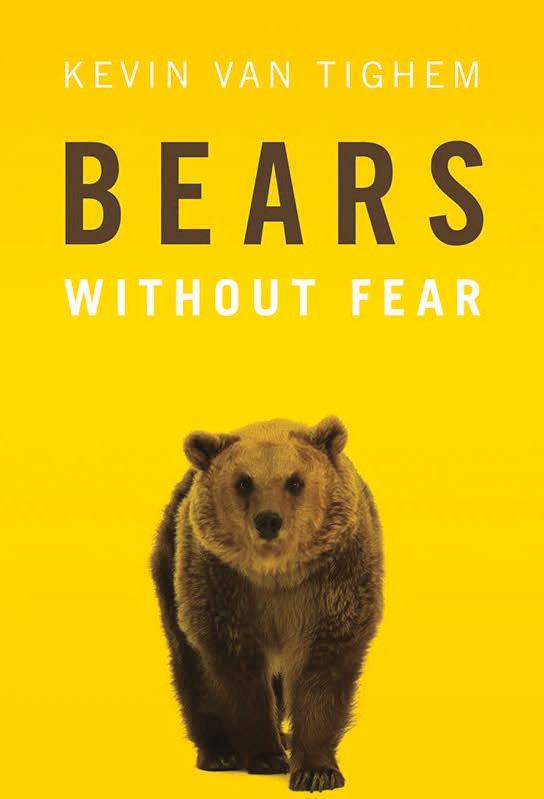



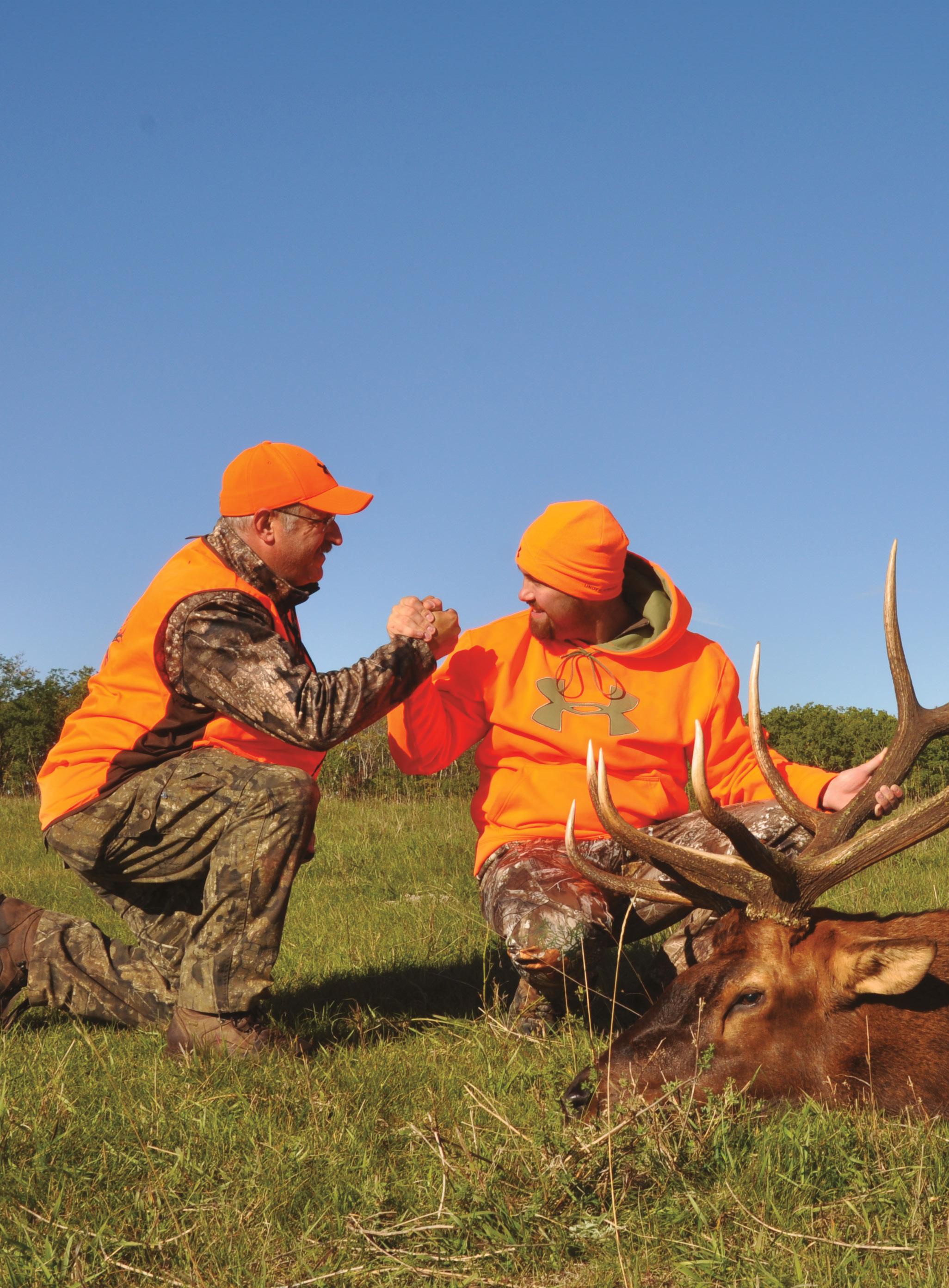
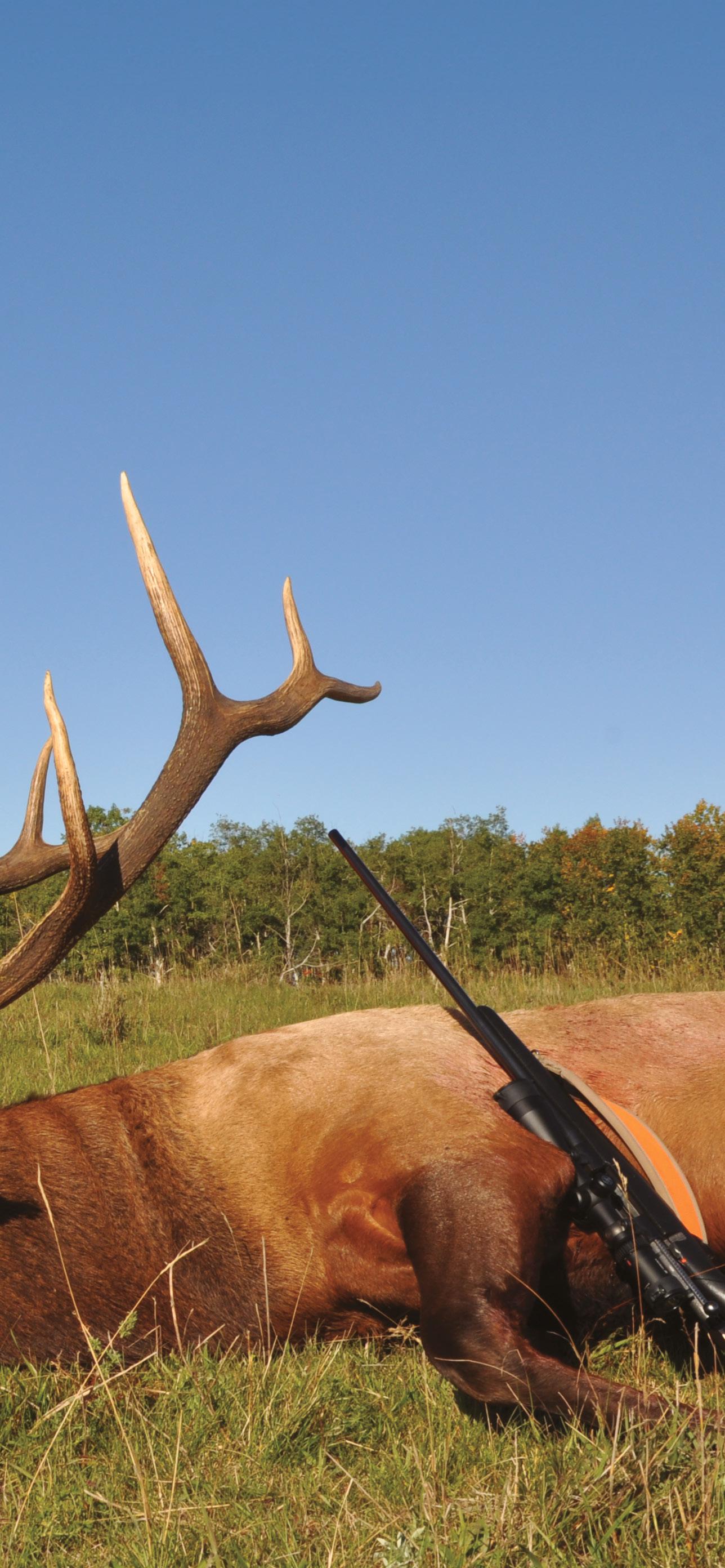
BY MIKE HUNGLE
calling, everything you need to know to outsmart a wary bugler
PLAIN AND SIMPLE, elk hunting isn’t easy. These are smart critters, often living in rugged terrain. They’re also extremely elusive, and true survivors. Some hunters call them “ghosts of the forest,” because if elk sense any potential danger, they disappear, often without ever being seen. Very seldom do you simply luck out and fill your tag. No, you must hunt hard to earn a big bull. But you can tip the odds in your favour. To help set you up for success, here are 13 essential tips on every aspect of hunting for elk.
#1}
ELK HUNTING INVOLVES a lot of walking while carrying a bow or firearm, as well as a backpack. Often this entails traversing hilly terrain, as well as stepping over logs, pushing into thick underbrush and trudging through mud. And once an elk is down, it takes plenty of physical effort to field dress and pack out the bounty.
With all that in mind, go for a long walk every day well before hunting season gets underway, gradually increasing the distance on each outing. Ideally, you want to walk up and down hills while carrying a full back pack. Lifting a few weights every other day will also help build the endurance and strength you’ll need for the rigours of the hunt.


SINCE ELK ARE incredibly tough, shot placement is crucial to bring one down. And putting a bullet or arrow exactly where it needs to go won’t always be easy. You may have to shoot through heavy cover, for example, or up or down a hill. You may even be caught off-balance when a shot opportunity arises, or find yourself in heavy rain or snow.
So, the more you practice shooting, the more confident you’ll become when it’s time to actually make that lethal shot.
Spending time on the range also helps you become more familiar with your equipment. Elk fever has a way of mesmerizing a person, and it can kick in faster than an approaching bull. If you’ve had plenty of practice, though, you’ll be able to automatically come to full draw or click off the safety on your rifle when a big bugler appears.
When you know the terrain well, you can devise various plans
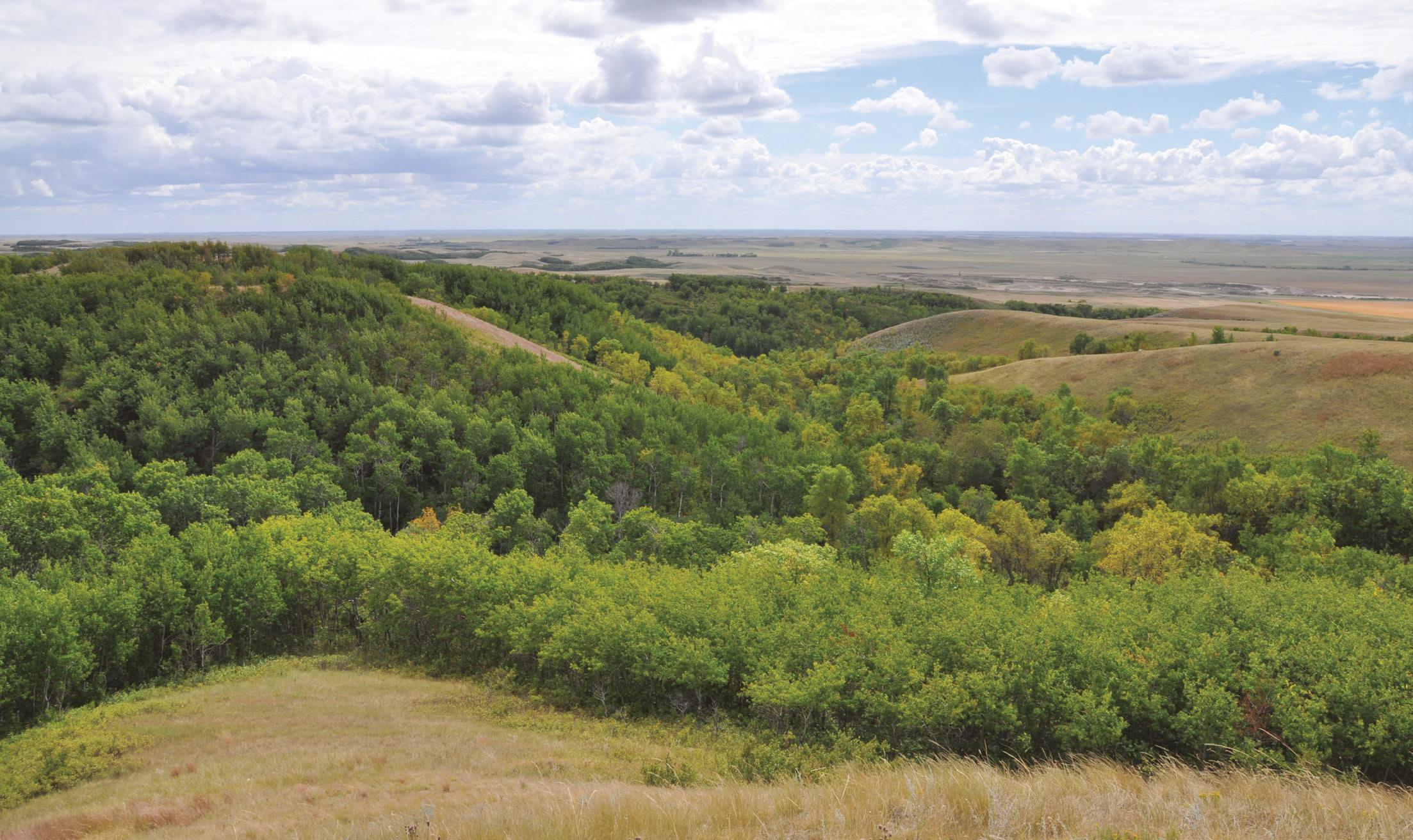
#3}
THE MORE YOU know your hunting grounds, the better your chances of finding elk. Before the season begins, spend time walking through the area and reviewing aerial photos or satellite images from Google Earth. In particular, it’s vital to identify the terrain where elk feed, water, travel and bed. While these areas typically remain the same from year to year,
logging or rotational farming can change things up. For example, elk like to feed on canola, but the locations of canola fields typically move each year. That impacts how and where the elk will travel to reach those places.
Getting to really know an area also lets you access hunting spots via a variety of routes. That way, you can use the wind to your advantage (see #4), take a shortcut or simply ensure you don’t get lost, especially in the dark.
#4}
AS WITH HUNTING any big game, scent control is paramount. Elk have incredibly sensitive sniffers, however, so even the best attempts to conceal your odour using special soaps, scent-blockers and apparel are often futile. No, your best bet is to work with the wind, always striving to remain downwind of the elk you are hunting.
#5}
ELK ARE GENERALLY secretive and live most of their lives in remote locations. They will feed in open agricultural fields, but often that’s only early and late in the day, or under the cover of darkness once hunting pressure increases. Otherwise, they’ll travel long distances from roads and wide-open fields to their bedding areas among trees, where they can safely rest away from people. They’ll often be on their feet for a few hours after sunrise, and again before sunset.
While sitting over a feeding field can be productive, it often provides only a short window of opportunity. For all-day opportunities, hike a few kilometres into the forest or pastureland. That gives you a chance to find elk in their hidden-away sanctuaries, where they’re typically more relaxed.

It pays to search for elk resting in their remote hideaways
ELK OFTEN BED close to a water source, which they’ll visit early and late each day. During hot weather, they may head to the water at various times throughout the day. While elk will drink and wade in lakes and large sloughs, they most often visit out-of-the-way freshwater ponds and springs, which are my favourite places to look for buglers. The telltale sign that elk are using a watering hole will be a series of trails leading to and from it, along with tracks in the surrounding mud.
When hunting near water, it’s wise to assume elk aren’t far off. To avoid spooking them, I always approach a watering area with the wind in my face, even if it means circling a long way around.
I FIND THAT bull elk will generally respond to an early-morning bugle, often before the sun has fully risen. While having a bull scream back as he comes charging in is exciting, that seldom happens for me. Instead, a bull will typically only respond once or twice, then go silent. That at least gives me an idea of where he’s located so I can go after him.
While bugling, I try not to sound like a giant bull, as that can sometimes cause any nearby bulls to remain silent. If there’s a herd bull in the vicinity with a harem of cows and some satellite bulls, the satellite bulls will occasionally bugle at each other. When that happens, I will stop bugling and start advancing toward them.
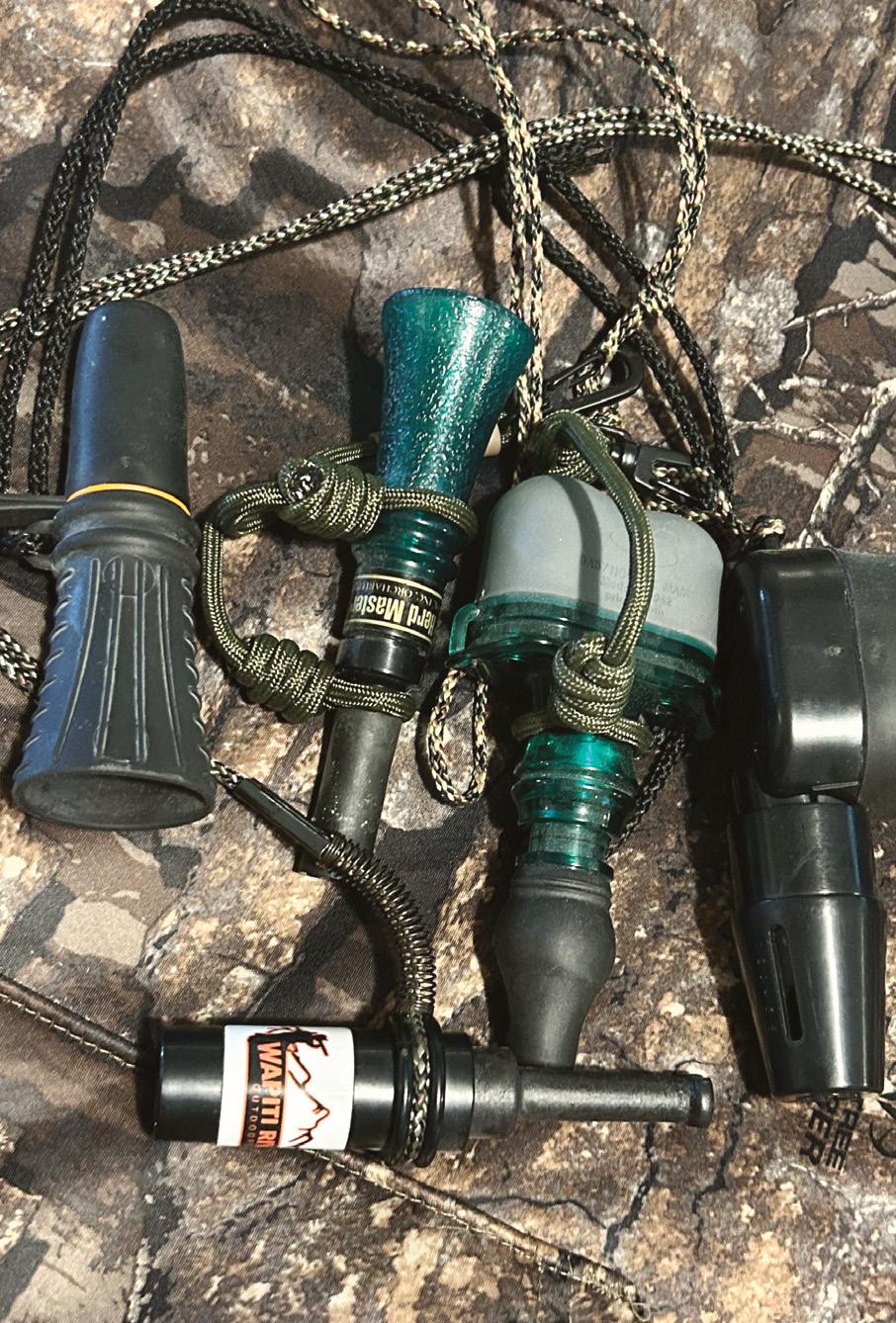
Carry a variety of calls in order to mimic both cows and bulls


ELK ARE VERY vocal, and often you can hear cows calling softly before you see them. Cow calls will draw elk in, so if you’re hunting with a partner, have that person set up 100 metres downwind of where you’re hiding out. Then start calling using three to five different cow calls to mimic a herd. The chances are good a bull will then sneak in between you and your buddy. When you are walking through the woods,
bull. Each time the cow chirped, the bull bugled back. Ever since then, whenever I know where a bull is located, I’ll cow call as I head toward him. The bull will often respond, then start moving toward me. When that happens, I keep advancing while cow calling, but won’t bugle back.
WHILE WALKING AND calling to find elk, occasionally stand still for extended periods to quietly scan your surroundings with binoculars and listen. If there are no signs of elk, move forward a few more metres and repeat the process.




head or back, which will stand out as a horizontal form in the vertical environment of the forest. Sometimes, a mere flash of movement will give away an elk walking through the brush. Be aware that if you spot one elk, there are likely more nearby.
Elk are noisy when they walk, so listen for the sound of breaking branches. They’ll also often chirp and mew as they move along; occasionally, a bull may even bugle. Once you hear elk, you have three choices: sit tight and let them give themselves away, call to them, or go after them
If you spot one elk, the chances are good more are nearby
MIKE HUNGLE
SITTING AROUND CAMP and enjoying a hot midday meal might sound appealing, but that will definitely reduce your chances of filling a tag. For the best odds, hunt all day long. Don’t be afraid to walk in and out of your hunting location in the dark, putting you exactly where you want to be when the sun rises and sets. This is when knowing your hunting area and getting off the beaten path really shines.
To stay energized, bring along a lunch, some snacks and a water bottle if the local natural water sources are unsafe (see #11). Store your food in sealable plastic bags, which won’t make noise when crumpled up in your backpack. In case of inclement weather, also pack raingear, some extra socks and an additional layer or two of clothing.
STAYING HYDRATED WHILE hunting is essential. It helps you keep a clear mind, while regulating your body temperature, reducing blisters, lubricating joints and preventing stiff and aching muscles. In the areas where I hunt, I don’t trust the water in the creeks and ponds, so I carry my own supply. To reduce weight, I use plastic water bottles instead of glass or stainless steel containers.
Throughout the day, make a point of periodically sipping some water. And when you work up a sweat, make sure to drink enough to completely rehydrate. If you do harvest an elk, drink water while field-dressing, skinning and hauling out the animal. It may take a special effort to remind yourself, but the few seconds it takes to stop and drink some water will help you feel better when the work is done.



#12}
ELK POSSESS KEEN hearing. While they’re used to the normal sounds of the outdoors, such as the rustling of leaves in the wind and the trickling of water, avoid making unnatural noises that will announce your presence. Binoculars clunking against a rifle stock or elk calls bouncing together, for example, mean danger to elk, and they won’t stick around long. If you’re carrying gear that might make noise, tuck it into your jacket or pack.
Talking, coughing or blowing your nose will also spook elk. To communicate with hunting buddies, then, either whisper at close range or use hand signals.
Also watch your step when walking through elk country. If you happen to snap a twig, quickly let out a soft cow elk call or two to help disguise your presence. And never slam your truck door, even if you’re parking far away from your hunting area.

#13}
THINGS CAN, AND often will, go sideways over the course of a hunt. But when you’re in elk country, never give up—you can’t take a bull from your couch, camper or tent. If the elk somehow wind you and spook when coming to your call, for example, take note of what may have gone wrong. Then give the elk some time to relax before going after them again. If something else spooks your quarry, use your geographical knowledge of the area to find them again and
Persistence and a positive attitude are often rewarded
make another plan of attack. Attitude is important. Always remain positive that a choice opportunity will arise. Hunt hard, and give it your best shot. If you’ve done your homework, it may only be a matter of time before you spot that bull of your dreams. And even if you don’t fill your tag, at least you’ll have had the satisfaction of spending time in elk country. OC
SASKATCHEWAN CONTRIBUTOR


BY GORD PYZER

Big baits catch big fish is an accepted rule of thumb, but for giant pike and muskies, it turns out lanky lures are a better option
IF YOU HAD asked me 10 years ago if I thought throwing a bigger bait would improve your chances of catching a storybook muskie or legendary northern pike, I’d have answered in the affirmative. These days, though, it’s not that simple. And know this: I am an old dog, so I’ve only begrudgingly come to grips with this new trick. But the more time I spend poring over studies in leading scientific journals and talking to fisheries researchers, the more I’m convinced that instead of talking about bigger baits to catch these queens of the lake, we should be focusing our attention instead on longer lures.
Among those scientists who’ve swayed my thinking is Kamden Glade (pictured), who undertook one of the most exhaustive studies of what muskies and pike are eating by flushing out their stomachs,
then using DNA analysis to identify the partially digested contents. Now employed by the Minnesota Department of Natural Resources, he initiated his post-graduate research, ironically, to address a question in the minds of many anglers: Are muskies and pike eating my walleye?
“You see videos online every once in a while of somebody reeling in an eater walleye and then a muskie comes up from the depths and grabs it,” Glade says. “That’s a really striking image for a lot of people. And it makes you wonder if maybe that’s what’s going on naturally, as well.”
In studying lakes both with and without muskies, he also wanted to learn what largemouth bass, walleye and northern pike were eating, and if there was any overlap in their diets that might lead to competition for food. Further, Glade wanted to know if that competition could affect reproduction and growth down the line. In answering those questions, he helped me refine my own lure selection process and presentation tactics for big toothy critters.
ACCORDING TO GLADE’S research, perch were the most important food for muskies, accounting for approximately one quarter of their diet. Suckers and invertebrates then accounted for roughly 10 per cent each, while bullheads, pike, bass and sunfish each made up about five per cent. The remainder were unidentified fish. (Since the netting and electro-fishing for his study were conducted in areas of the lakes where ciscoes were not present, they did not factor in his findings.) Glade remembers one specific muskie—he calls it his poster child—that had 101 individual prey fish in its stomach when he captured it by electrofishing. Ninetyseven were yellow perch, along with the parts of two bullheads, a sucker and a sunfish.
What sticks out here is that walleye were nowhere to be found on Glade’s list of top muskie menu items, even though they were plentiful in the lakes he studied. Not only that, the walleye often mingled with the same yellow perch and white suckers the big toothy critters were
wolfing down. So, are muskies purposefully avoiding walleye?
“I’m hesitant to say it has anything to do with location, because there were lots of times when we were electrofishing we’d go through a pod of walleye, scoop a bunch up and then not 10 yards down the weedbed or breakline, there would be a big muskie hanging out and we’d get it, too,” Glade says.
Instead, he suggests it could be the muskies are actively avoiding the walleye. “They have lots of sharp spines and scales, and their gills can be pretty sharp and rough,” Glade observes. “I know I’ve gotten poked and scratched many times, so I can’t imagine that’s a very pleasant experience for a muskie.”
Another possibility is the walleye are just better at avoiding being eaten than the other species. “Walleye are predators just like muskies,” Glade says. “They’re built a little bit differently, but in both cases, they’re built for really quick bursts of speed that help them capture their prey. And so that might be just enough to help them get away from muskies.”
So much for tying on chunky, walleye-shaped baits.


GIVEN THE GASTRONOMIC priority muskies place on yellow perch, it’s not surprising Glade discovered the popular panfish also ranked high on the northern pike dinner menu. However, instead of mimicking muskies for the balance of their dietary delights—as you might logically assume—pike much more closely resembled walleye when it came to their eating habits.
“Pike and walleye had the most similar diets of any two species pairs that we looked at,” says Glade. “And they ate primarily perch, sunfish and crappies. The exact proportions were different depending on the lake. There was a bit of a trade-off between eating more perch in one system and more panfish in another system. But across the board, perch, sunfish and crappies made up over 80
per cent of both walleye and pike diets. They were really keyed in on those prey items.”
Listening to Glade detail the close association between northern pike and walleye was a eureka moment for me. As I have written about often, when I first started casting five- and six-inch-long swimbaits for trophy-sized walleye, I was often bitten off by ghostly predators while fishing deeper main-lake structures. As much to enjoy catching those bonus giant pike as saving my precious baits, I started using ultra-thin, foot-long, tieable stainless steel wire leaders. After landing scores of giant northern pike weighing up to 30 pounds doing this, I found Glade’s scientific findings made all the more sense.
And again, it showed that slender trumps chubby when it comes to bait choices.
GLADE’S STUDY LAKES included four different types of systems, including waterbodies with and without ciscoes. Those soft, silvery, oily, cold-water pelagic baitfish are typically associated with the thermocline, and they’re so nutritiously rich they produce big fish almost everywhere you find them in abundance.
In the lakes where there were no ciscoes at all, guess what Glade discovered was the most important food item for muskies? Their northern pike cousins. I almost fell off my chair when he said that, because over the years the most observable thing I’ve seen sticking out of the mouths of the giant muskies and northern pike I’ve caught has been the tail of a smaller pike. Consider also the many images you’ve probably seen on social media of a gargantuan» Northerns and walleye are much alike in their feeding habits
northern pike or muskie floating dead on top of the water with an almost same-sized pike wedged in its throat.
“A 20-inch pike is kind of average for the sizes we saw,” says Glade. “If you think about it, it’s just a giant hot dog with fins that’s swimming around in the water. It’s one of those things that’s really easy to swallow. And in a lot of our lakes, they’re just really abundant. So, it just makes it all the more probable that a muskie is going to swim by and grab one.”
Did you catch the average size of the pike Glade found in the stomachs of the muskies he examined? Now ask yourself, when was the last time you threw or trolled a 20-inch-long lure? Probably never, right? But it confirms what the fisheries science literature has highlighted for years, and that is the maximum size prey eaten by northern pike and muskies typically ranges between 32 and 46 per cent of the predator’s total length. I am certain—at least in part—this is why anglers opt for bigger-is-better when it comes to lure selection for targeting giant-sized muskies and northern pike. But it doesn’t tell the whole story, because when we look at the median size of the prey eaten by the very same fish—not the
biggest or smallest, but the size of the prey in the middle—it typically ranges between 10 and 20 per cent of the predator’s total length. So, for a 40-inch muskie or pike, the median-sized prey measures four to eight inches in length, while for memorable 50-inch fish, it is five to 10 inches.
What this diet research highlights is that the critical parameter is the length of the prey and its lean and spindly shape, which fisheries folk refer to as “fusiform.” So, while a giant muskie might think nothing of wolfing down a slender 20-inch pike, it might pass up a short, plump 12-inch drum or carp.
Indeed, let’s look again at those sleek ciscoes that are generally regarded as nature’s perfect food for muskies and northern pike, as well as for walleye and lake trout. When they are abundant and heavily predated, guess what they have been observed to do to avoid becoming dinner? They grow stouter and girthier so the predators have difficulty stretching their mouths open wide enough to swallow them.
“Our results indicate there may be a cap on the size of cisco that muskellunge can or will consume,” concluded a recent report from the Wisconsin Department of Natural Resources. “Further, mean lengths of cisco generally ranged from six »
Fisheries researcher Kamden Glade is a keen muskie and pike angler, as well as a top-flight scientist, so how does he benefit from his findings when he heads out on the water? For starters, he avoids throwing big baits in part because of the many times he’s discovered the larger fish eating three-inch yellow perch, five-inch sunfish and even mayfly larvae. Plus, he says, the shoulder ache isn’t always worth it.
Secondly, Glade cautions that muskies, in particular, aren’t always the solitary predators anglers believe them to be. With that in mind, he stays on structure he knows to hold big fish, and is never in a rush to leave. Good spots, Glade explains, often hold multiple fish.
Finally, when he catches a memorable muskie, Glade looks for identical locations rather than bounce around to a variety of different spots, such as sand flats, weedbeds and offshore rocky structures and cover.

ENTRY DEADLINE: JANUARY 2, 2025


THIS CONTEST IS only open to residents of Canada (except Quebec). No purchase is necessary. Professional photographers are not eligible. Photos must have been taken in Canada on or after January 1, 2024. Entries must include details of when and where the pictures were taken. Please enter your high-resolution digital images online at: WWW.OUTDOORCANADA. CA/OCPHOTOCONTEST

PHOTOS DEPICTING ANY ASPECT OF SPORTFISHING IN CANADA

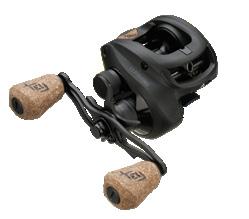

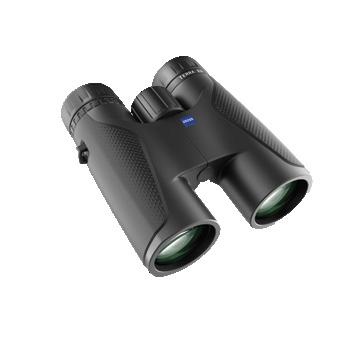


1ST PLACE: 13 Fishing Rod, Reel & Gear Prize Pack (MSRP $500)

2ND PLACE: 13 Fishing Tackle Prize Pack (MSRP $250)
3RD PLACE: 13 Fishing Tackle Prize Pack (MSRP $100)


1ST PLACE: Zeiss 3-12x44 Conquest V4 Riflescope (MSRP $1,199.99)
2ND PLACE: Zeiss Terra 10x42 binoculars (MSRP $899.99)
3RD PLACE: Zeiss Terra 10x25 compact binoculars (MSRP $649.99)
PHOTOS DEPICTING YOUNG CANADIANS ENJOYING

WWW.FENWICKFISHING.COM

1ST PLACE: Fenwick Family Fishing Package (MSRP $1,000)
2ND PLACE: Package
3RD PLACE: Package

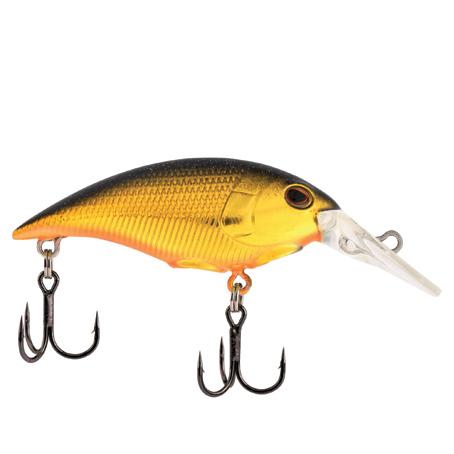

PHOTOS DEPICTING WILDLIFE AND/OR NATURAL LANDSCAPES IN CANADA
1ST PLACE: Nest Pour Over Kit + Java G25 Coffee Grinder Bundle (MSRP $280)
2ND PLACE: Java G45 Coffee Grinder (MSRP $280)
3RD PLACE: Nest Pour Over Coffee Kit + Nest Mug (MSRP $120)





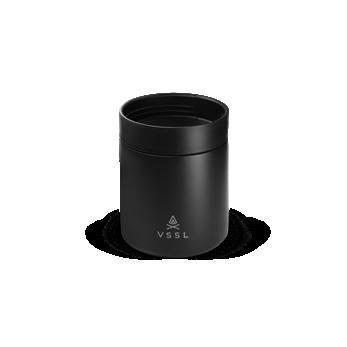
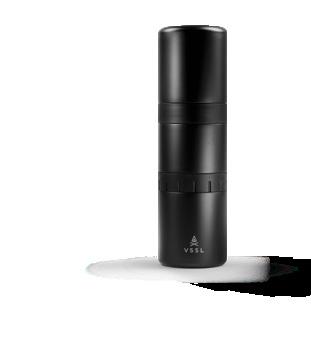
to 12 inches, suggesting that gape limitation and exceedance of the preferred size [for muskies] was likely occurring.”
I’M BETTING BY now the same light that went on for me is now turning on for you, too. Namely, when it comes to lure selection, the fusiform shape is better for attracting and triggering big toothy critters, rather than the prevailing preference for so-called bigger baits. And it opens up an exciting new fishing frontier.
For the past few years, for example, I’ve been creating my own super-slender, 15-inch-long tube jigs that closely resemble the giant hot dog-shaped pike Glade discovered in the stomachs of the fish he sampled. I simply take two 10-inch Waterwolf tube jigs and cut the tail off one and the nose off the other, then bind them together using Mend-it soft-bait glue. I believe I’ve never caught more and bigger fish slinging this spindly creation, which I call the “Miss Twiggy Tube.” The same goes with tying on the longest, leanest swimbaits I can find, such as skinny 14-inch Warhammers from Toddy Tickle Baits.
Yes, these baits are big, but much more importantly, they are longer and much slimmer than traditional toothy critter baits—precisely what Glade’s memorable-sized muskies and northern pike seem to be craving. I am betting, too, that in the weeks, months and years to come, we’ll see many more lure makers jump on the long-andskinny bandwagon.
I’ll leave you with one last reason why I’ve already jumped on the bandwagon. Late last November, I was throwing one of my Miss Twiggy Tubes on a spot where muskies intercept schools of ciscoes and whitefish coming ashore to spawn. I parked the boat in about 20 feet of water—it was 80 feet deep immediately behind me—and pitched the spindly tube up on to the shoal that topped out in about eight feet of water. I snapped it once, let it suspend and slowly flutter down, then popped it again to make it look like an emaciated cisco on its deathbed.
Giant fish devour fusiform swimbaits such as the Warhammer

Suddenly, a giant muskie engulfed the bait, and I set as hard as I could. As the fish dove toward the deep water, I tapped the spot-lock function on my electric trolling motor to hold me in place, then grabbed the net and moved to the stern, where it’s closer to the water and easier to land a big fish when fishing alone. I kneeled down on the back casting platform, and with my right arm slowly raised the rod and pulled the fish toward the giant net I held in my outstretched left arm.
The moment the fish felt the net’s cold steel rim touch its jaw, however, it thrashed violently and flung the hook free. If that wasn’t bad enough, it then finned effortlessly on the surface, not 10 feet away, and looked me straight in the eye as it flicked its tail and disappeared. It was the biggest muskie I’ve ever hooked and lost. Now you know where I’ll be this November, pitching a long, slender lure. OC
TUNE INTO “DOC TALKS FISHING” ON YOUR FAVOURITE PODCAST PROVIDER TO HEAR FISHING EDITOR GORD PYZER AND LIAM WHETTER
INTERVIEW KAMDEN GLADE ABOUT HIS FASCINATING RESEARCH.
A fascinating takeaway from fisheries scientist Kamden Glade’s diet research is that yellow perch are the most important source of food for muskies, northern pike and walleye. And that helps explain why green, yellow, black and chartreuse—especially in combination—are the lure colours of choice for so many anglers. It also sheds light on the fact that perch are modest in stature, typically stretching eight to 12 inches in length, supporting what I’ve opined for years. Namely, a modestsized, firetiger-coloured Super Shad Rap-style lure is the ultimate “small” bait for attracting and triggering husky muskies and giant northern pike to strike.
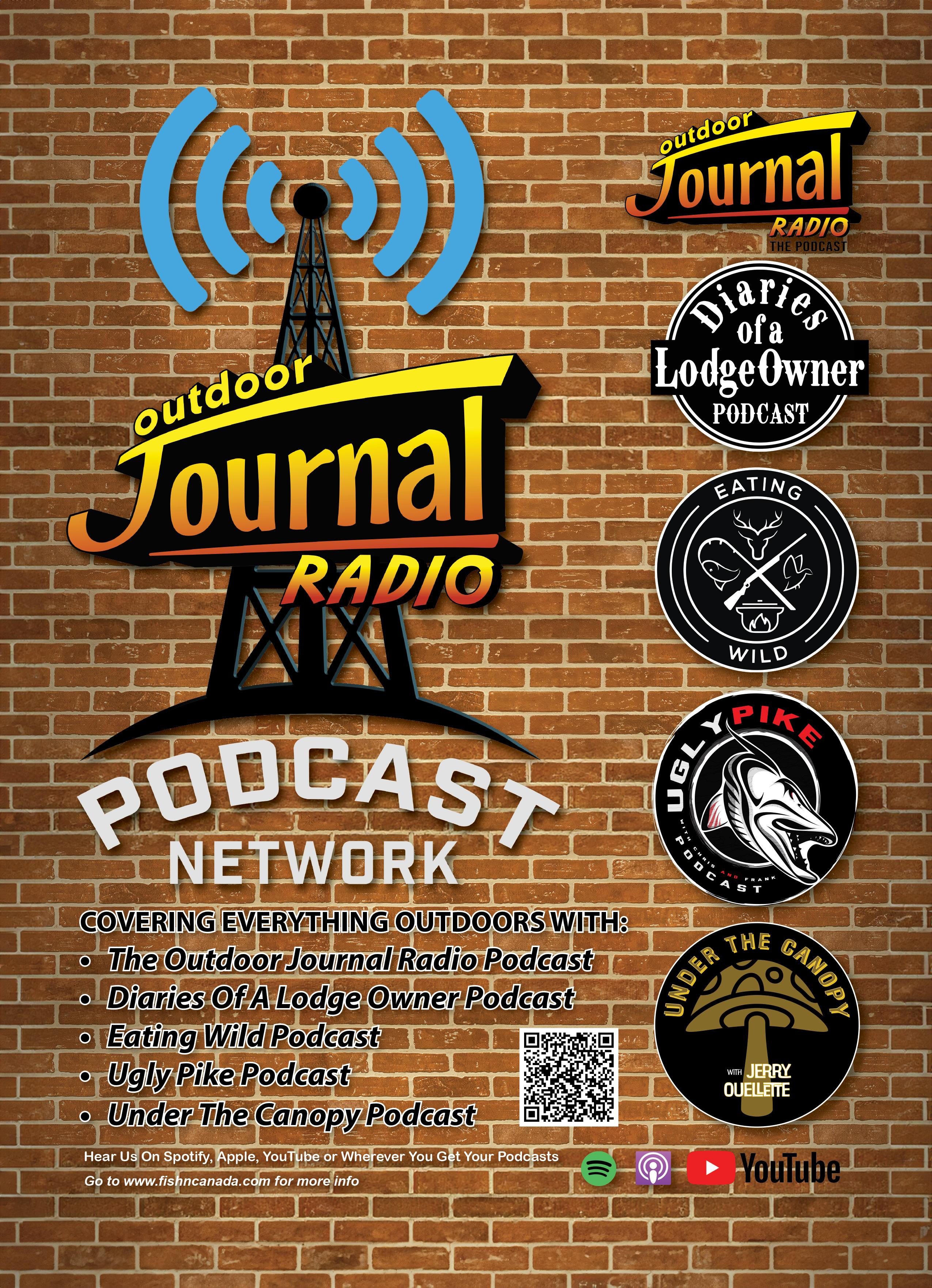
BY ROBERT PYE

HUNT ’EM UP!” In hunting dog speak, those are words of unconditional love, unwavering encouragement for pointers, flushers, retrievers and hounds to do what they were born to do. It’s my gentle pet pep talk, cheering on my best friends as they pursue their innate infatuation with wide-open hunting spaces and the scent of game. I’ve been hunting ’em up with English setters for more than half my life. My first four setters now hunt the happy hunting grounds in the sky, but their genetics live on in my current pair. Digby is in his absolute prime, while Poppy recently began nursing her whelping box full of hunting futures.
A litter of puppies begins a new leash on life for hunting families such as mine. Long before new bird dogs learn about their role in the woods, they first discover a place in our hearts. Dogs are fondly written into the most memorable chapters in our book of life, especially those breeds that will hunt a dozen Decembers by your side. That first
buck, bull or boar are all hunting firsts that push us even harder in our personal outdoor journeys. But the sweetest hunting first of all is that first bird taken over the point of a young dog.
In my house, sleeping setters awaken at the subtle sound of a key unlocking the gun cabinet door. Their ears are as sharp as their nose. And the mere sight of my upland game vest only affirms what they heard is true—it’s time to hunt ’em up! Tail-twirling enthusiasm goes on for kilometres on end in our pursuit of ruffed grouse and woodcock, and when my dogs stop figureeighting through the softwoods ahead, I’m confident one is on point. Now it’s my turn to deliver. The gun goes up and the bird comes down. Then the only thing louder than the 12-gauge is my lofty praise: “Good dog!” OC
ROBERT PYE’ S TWO ENGLISH SETTERS, POPPY AND DIGBY (PICTURED ABOVE), ARE ALWAYS GAME TO HEAD AFIELD.



HUNTING OPTICS: BINOCULARS RANGEFINDERS SCOPES
THE BUSHNELL R-SERIES IS A FULL-SPECTRUM OF OPTICS DESIGNED EXCLUSIVELY FOR WHITETAIL HUNTING. ENGINEERED TO EXCEL IN TIGHT COVER AND MID RANGE HUNTING ENVIRONMENTS AND LOADED WITH ALL THE
NECESSARY FEATURES TO KEEP YOU IN THE HUNT FROM DAWN TO DUSK.


